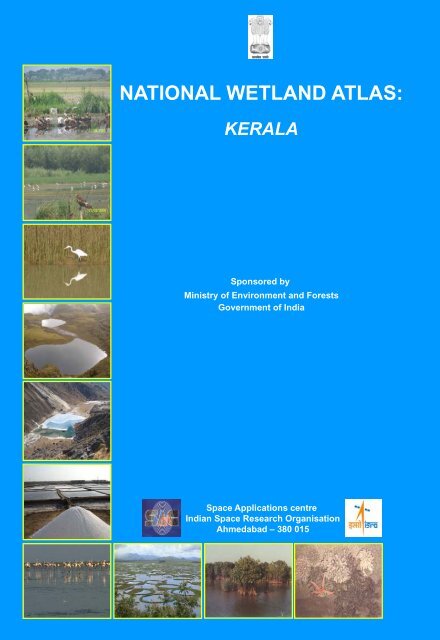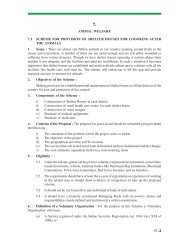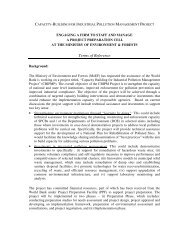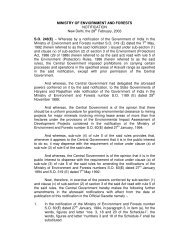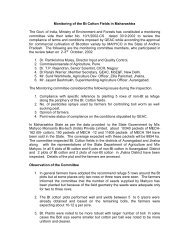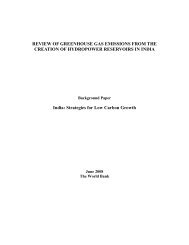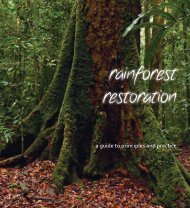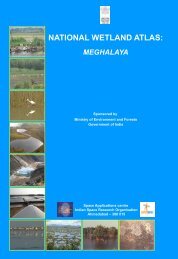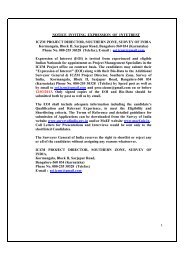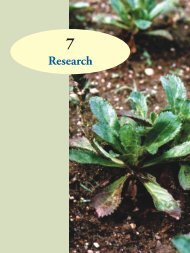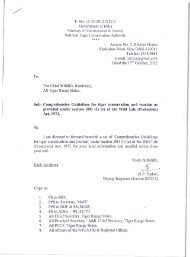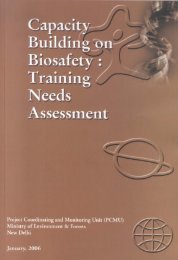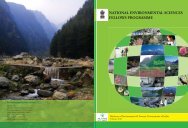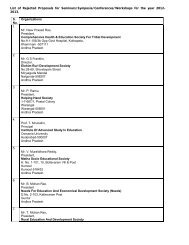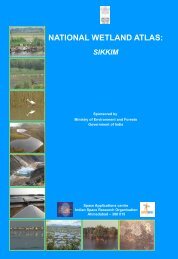National Wetland Atlas: Kerala - Ministry of Environment and Forests
National Wetland Atlas: Kerala - Ministry of Environment and Forests
National Wetland Atlas: Kerala - Ministry of Environment and Forests
- No tags were found...
You also want an ePaper? Increase the reach of your titles
YUMPU automatically turns print PDFs into web optimized ePapers that Google loves.
<strong>Atlas</strong>SAC/RESA/AFEG/NWIA/ATLAS/14/2010NATIONAL WETLAND ATLASKERALASponsored by<strong>Ministry</strong> <strong>of</strong> <strong>Environment</strong> <strong>and</strong> <strong>Forests</strong>, Government <strong>of</strong> IndiaAs a part <strong>of</strong> the project on <strong>National</strong> <strong>Wetl<strong>and</strong></strong> Inventory <strong>and</strong> Assessment (NWIA)Space Applications Centre (ISRO), Ahmedabad<strong>and</strong><strong>Kerala</strong> State Remote Sensing & <strong>Environment</strong> Centre, ThiruvananthapuramFebruary 2010
First Publication: February 2010, Space Applications Centre (ISRO), AhmedabadCopyright:2010, SAC, ISROThis publication may be produced in whole or in part <strong>and</strong> in any form for education or non-pr<strong>of</strong>it uses,without special permission from the copyright holder, provided acknowledgement <strong>of</strong> source is made. SACwill appreciate a copy <strong>of</strong> any publication which uses this publication as a source.Citation: <strong>National</strong> <strong>Wetl<strong>and</strong></strong> <strong>Atlas</strong>: <strong>Kerala</strong>, SAC/RESA/AFEG/NWIA/ATLAS/14/2010, Space ApplicationsCentre(ISRO), Ahmedabad, India, 130p.Available from:Production:Space Applications Centre, ISRO, Ahmedabad – 380 015, IndiaSAC carried out the work jointly with <strong>Kerala</strong> State Remote Sensing & <strong>Environment</strong> Centre,Thiruvananthapuram, Sponsored by <strong>Ministry</strong> <strong>of</strong> <strong>Environment</strong> <strong>and</strong> <strong>Forests</strong>, Govt. <strong>of</strong> India.ii
MESSAGEIt gives me great pleasure to introduce this <strong>Atlas</strong>, the latest in a series, prepared by Space ApplicationsCentre, Ahmedabad in connection with the <strong>National</strong> <strong>Wetl<strong>and</strong></strong> Inventory <strong>and</strong> Assessment Project.This <strong>Atlas</strong> maps <strong>and</strong> catalogues information on <strong>Wetl<strong>and</strong></strong>s across India using the latest in satellite imaging,one <strong>of</strong> the first <strong>of</strong> its kind. <strong>Wetl<strong>and</strong></strong>s are areas <strong>of</strong> l<strong>and</strong> critical ecological significance that support a largevariety <strong>of</strong> plant <strong>and</strong> animal species adapted to fluctuating water levels. Their identification <strong>and</strong> protectionbecomes very important.Utility-wise, wetl<strong>and</strong>s directly <strong>and</strong> indirectly support millions <strong>of</strong> people in providing services such as food,fiber <strong>and</strong> raw materials. They play important roles in storm <strong>and</strong> flood control, in supply <strong>of</strong> clean water, alongwith other educational <strong>and</strong> recreational benefits. Despite these benefits, wetl<strong>and</strong>s are the first target <strong>of</strong>human interference <strong>and</strong> are among the most threatened <strong>of</strong> all natural resources. Around 50% <strong>of</strong> theearth’s wetl<strong>and</strong>s are estimated to already have disappeared worldwide over the last hundred years throughconversion to industrial, agricultural <strong>and</strong> residential purposes. Even in current scenario, when theecosystem services provided by wetl<strong>and</strong>s are better understood - degradation <strong>and</strong> conversion <strong>of</strong> wetl<strong>and</strong>scontinues.Aware <strong>of</strong> their importance, the Government <strong>of</strong> India has formulated several policies <strong>and</strong> plans for theconservation <strong>and</strong> preservation <strong>of</strong> these crucial ecosystems. Realising the need <strong>of</strong> an updated geospatialdata base <strong>of</strong> these natural resources as the pre-requisite for management <strong>and</strong> conservation planning,<strong>National</strong> <strong>Wetl<strong>and</strong></strong> Inventory <strong>and</strong> Assessment (NWIA) project was formulated as a joint vision <strong>of</strong> <strong>Ministry</strong> <strong>of</strong><strong>Environment</strong> & Forestry, Govt. India, <strong>and</strong> Space Applications Centre (ISRO). I am told that the latestremote sensing data from Indian Remote Sensing satellite (IRS P6) have been used to map the wetl<strong>and</strong>s.The present atlas is part <strong>of</strong> this project <strong>and</strong> highlights the results <strong>of</strong> the study state in terms <strong>of</strong> statistics <strong>of</strong>various types <strong>of</strong> wetl<strong>and</strong>s, extent <strong>of</strong> water, aquatic vegetation <strong>and</strong> turbidity in pre <strong>and</strong> post monsoon period.I also note that special efforts are made to provide detailed information <strong>of</strong> important wetl<strong>and</strong>s like Ramsarsites, <strong>National</strong> Parks etc.I am certain that this <strong>Atlas</strong> will raise the bar in developing such database <strong>and</strong> will be <strong>of</strong> great use forresearchers, planners, policy makers, <strong>and</strong> also members <strong>of</strong> the general public.iii
FOREWORD<strong>Wetl<strong>and</strong></strong>s defined as areas <strong>of</strong> l<strong>and</strong> that are either temporarily or permanently covered by water exhibitenormous diversity according to their genesis, geographical location, water regime <strong>and</strong> chemistry. <strong>Wetl<strong>and</strong></strong>sare one <strong>of</strong> the most productive ecosystems <strong>and</strong> play crucial role in hydrological cycle. Utility wise, wetl<strong>and</strong>sdirectly <strong>and</strong> indirectly support millions <strong>of</strong> people in providing services such as storm <strong>and</strong> flood control, cleanwater supply, food, fiber <strong>and</strong> raw materials, scenic beauty, educational <strong>and</strong> recreational benefits. TheMillennium Ecosystem Assessment estimates conservatively that wetl<strong>and</strong>s cover seven percent <strong>of</strong> the earth’ssurface <strong>and</strong> deliver 45% <strong>of</strong> the world’s natural productivity <strong>and</strong> ecosystem services. However, the veryexistence <strong>of</strong> these unique resources is under threat due to developmental activities, <strong>and</strong> population pressure.This calls for a long term planning for preservation <strong>and</strong> conservation <strong>of</strong> these resources. An updated <strong>and</strong>accurate database that will support research <strong>and</strong> decision is the first step towards this. Use <strong>of</strong> advancedtechniques like Satellite remote sensing, Geographic Information System (GIS) is now essential for accurate<strong>and</strong> timely spatial database <strong>of</strong> large areas. Space Applications Centre (ISRO) took up this challenging taskunder the project “NWIA” (<strong>National</strong> <strong>Wetl<strong>and</strong></strong> Inventory <strong>and</strong> Assessment) sponsored by <strong>Ministry</strong> <strong>of</strong><strong>Environment</strong> & <strong>Forests</strong>. To account for numerous small yet important wetl<strong>and</strong>s found in the country, mappingat 1:50,000 scales has been taken up. Two date IRS LISS III data acquired during pre <strong>and</strong> post monsoonseason are used for inventory to account for wet <strong>and</strong> dry season hydrology <strong>of</strong> wetl<strong>and</strong>s. The map outputsinclude the status <strong>of</strong> water spread, aquatic vegetation <strong>and</strong> turbidity. Ancillary layers like road/rail, habitationsare also created. Very small wetl<strong>and</strong>s below the mappable unit are also identified <strong>and</strong> shown points. Theresults are complied as <strong>Atlas</strong>es <strong>of</strong> wetl<strong>and</strong>s for states/Union Territories <strong>of</strong> India. This <strong>Atlas</strong> highlights resultsfor a particular state/UT <strong>and</strong> hopes to improve our underst<strong>and</strong>ing <strong>of</strong> the dynamics <strong>and</strong> distribution <strong>of</strong> wetl<strong>and</strong>s<strong>and</strong> their status in the area.I congratulate the team for bringing out this informative atlas <strong>and</strong> sincerely hope that this will serve as auseful source <strong>of</strong> information to researchers, planners <strong>and</strong> general public.January 25, 2010v
ACKNOWLEDGEMENTSThe project “<strong>National</strong> <strong>Wetl<strong>and</strong></strong> Inventory & Assessment (NWIA)”, is sponsored by <strong>Ministry</strong> <strong>of</strong> <strong>Environment</strong> &Forestry (MoEF), Govt. <strong>of</strong> India <strong>and</strong> executed by Space Applications Centre, ISRO, Ahmedabad. We aregrateful to Dr. Ranganath R. Navalgund, Director, Space Applications Centre, for his encouragement to takeup this challenging task <strong>and</strong> formulation <strong>of</strong> the project team for timely implementation. Earnest thanks arealso due to Dr. Jai Singh Parihar, Dy. Director, Remote Sensing Applications Area, Space ApplicationsCentre, for providing overall guidance <strong>and</strong> support to the project. The present <strong>Atlas</strong> for the state <strong>of</strong> <strong>Kerala</strong> is apart <strong>of</strong> the “<strong>National</strong> <strong>Wetl<strong>and</strong></strong> <strong>Atlas</strong>.This project has benefited from the wisdom <strong>of</strong> many people. It is a pleasure to acknowledge the contributionsmade by the wetl<strong>and</strong> experts especially to Pr<strong>of</strong>. C.K. Varshney, Former Dean, School <strong>of</strong> <strong>Environment</strong>alSciences, Jawaharlal Nehru University, New Delhi, Pr<strong>of</strong>. A.R. Yousuf, The University <strong>of</strong> Kashmir, Srinagar,Pr<strong>of</strong>. Pradeeep Shrivastava, Head, <strong>Wetl<strong>and</strong></strong> Research Centre, Barakatullah University, Bhopal, Dr. PrikshitGautam, Director, WWF-India, Dr. S. Narendra Prasad, Salim Ali Centre for Ornithology <strong>and</strong> Nature,Coimbtore <strong>and</strong> Dr. R.K. Suri, Additional Director, <strong>Ministry</strong> <strong>of</strong> <strong>Environment</strong> <strong>and</strong> <strong>Forests</strong>, Govt. <strong>of</strong> India, NewDelhi, <strong>and</strong> the database experts from ISRO who participated in the peer Review meeting to finalise the“<strong>Wetl<strong>and</strong></strong> Classification System” followed in this projectWe acknowledge the positive role played by 16 th SC-B (St<strong>and</strong>ing Committee on Bioresources <strong>and</strong><strong>Environment</strong>) <strong>of</strong> NNRMS (<strong>National</strong> Natural Resources Management System) meeting in formulating thisproject. We are extremely thankful to the members <strong>of</strong> the“Steering Committee” <strong>of</strong> the project, under thechairmanship <strong>of</strong> Dr E J James, Director – Water Institute, Karunya University, for their periodical review,critical comments <strong>and</strong> appreciation <strong>of</strong> the efforts by the project team. We are thankful to SC-B under thechairmanship <strong>of</strong> Secretary, MoEF, for periodic review <strong>of</strong> the progress <strong>of</strong> the project <strong>and</strong> guidance towardstimely completion <strong>of</strong> the work. We acknowledge the valuable contributions made by Dr J K Garg, the thenscientist <strong>of</strong> SAC for his active role in formulation <strong>of</strong> this project, co-authoring the procedure manual document.We are grateful to Dr G V Subramanyam, Adviser, MoEF, for his very active <strong>and</strong> positive role forimplementation <strong>of</strong> the project. We are thankful to Dr Jag Ram, Director, MoEF <strong>and</strong> Dr Harendra Kharwal,MoEF for their support in budget <strong>and</strong> project management related issues. We are thankful to the “TechnicalReview” team <strong>of</strong> SAC for critical comments <strong>and</strong> suggestion to finalise the <strong>Atlas</strong>. We acknowledge the supportreceived from Dr P S Roy, Dy Director, NRSC <strong>and</strong> Dr S Sudhakar, Head, LRD, NRSC in terms <strong>of</strong> valuablesuggestions <strong>and</strong> providing the geo-referenced image <strong>of</strong> NRC-LU&LC project for use as master image in thisproject. We acknowledge the efforts put by Dr R D Shah, Mr Pragnesh Kumar Vaishnav <strong>and</strong> Ms Yatisha PVaishnav, Geology Department, M G Science Institute, Ahmedabad in finalization <strong>of</strong> GIS database.vii
PROJECT TEAMProject Director: Dr. (Mrs) Sushma PanigrahySpace Applications Centre, ISRO, AhmedabadShri J. G. PatelDr T. S. Singh<strong>Kerala</strong> State Remote Sensing & <strong>Environment</strong> Centre, ThiruvananthapuramShri R.P Sharma IFS, DirectorSmt. R.V Sheeja, ScientistShri P. Suresh, ScientistDr. N.C Anilkumar, ScientistShri Suraj . R, ScientistSmt. Suja Alex, Project Fellow<strong>National</strong> Remote Sensing Centre, HyderabadDr. S. Sudhakarix
CONTENTS1.0 INTRODUCTION1.1 <strong>Wetl<strong>and</strong></strong>s1.2 Mapping <strong>and</strong> geospatial techniques1.3 <strong>Wetl<strong>and</strong></strong> Inventory <strong>of</strong> India2.0 NATIONALWETLAND INVENTORY AND ASSESSMENT2.1 <strong>Wetl<strong>and</strong></strong> Classification System2.2 GIS database contents3.0 STUDY AREA4.0 DATA USED5.0 METHODOLOGY5.1 Creation <strong>of</strong> spatial framework5.2 Geo-referencing <strong>of</strong> satellite data5.3 Mapping <strong>of</strong> wetl<strong>and</strong>s5.4 Conversion <strong>of</strong> raster (indices) into a vector layer5.5 Generation <strong>of</strong> reference layers5.6 Coding <strong>and</strong> attribute scheme5.7 Map composition <strong>and</strong> output6.0 ACCURACY ASSESSMENT7.0 WETLANDS OF KERALA: MAPS AND STATISTICS7.1 District-wise <strong>Wetl<strong>and</strong></strong> Maps <strong>and</strong> Statistics7.1.1 Kasaragod7.1.2 Kannur7.1.3 Wayanad7.1.4 Kozhikode7.1.5 Malappuram7.1.6 Palakkad7.1.7 Thrissur7.1.8 Ernakulam7.1.9 Idukki7.1.10 Kottayam7.1.11 Alappuzha7.1.12 Pathanamthitta7.1.13 Kollam7.1.14 Thiruvananthapuram8.0 MAJOR WETLAND TYPES OF KERALA9.0 IMPORTANT WETLANDS OF KERALA10.0 SOI SHEET-WISE WETLAND MAPS (selected sheets)ReferencesAnnexure–I: Definitions <strong>of</strong> wetl<strong>and</strong> categories used in the project.Annexure–II: Details <strong>of</strong> district information followed in the atlasList <strong>of</strong> FiguresFigure 1: Spectral Signature <strong>of</strong> various targetsFigure 2: Various l<strong>and</strong> features as they appear in four spectral b<strong>and</strong>s <strong>and</strong> in a typical three b<strong>and</strong> FCC.Figure 3: Location mapFigure 4: Spatial framework <strong>of</strong> <strong>Kerala</strong>Figure 5: IRS P6 LISS-III coverage <strong>of</strong> <strong>Kerala</strong>Figure 6: IRS LISS-III FCC(Post-monsoon <strong>and</strong> Pre-monsoon) : Part <strong>of</strong> <strong>Kerala</strong> stateFigure 7: Flow chart <strong>of</strong> the methodology usedxi
Figure 8: Steps in the extraction <strong>of</strong> wetl<strong>and</strong> componentsFigure 9: Various combinations <strong>of</strong> the indices/spectral b<strong>and</strong>s used to identify wetl<strong>and</strong> componentsFigure 10: Type-wise wetl<strong>and</strong> distribution in <strong>Kerala</strong>Figure 11: District-wise graphical distribution <strong>of</strong> wetl<strong>and</strong>sList <strong>of</strong> TablesTable 1: <strong>Wetl<strong>and</strong></strong> Classification System <strong>and</strong> codingTable-2: Satellite data usedTable 3: Qualitative turbidity ratingsTable 4: Area estimates <strong>of</strong> wetl<strong>and</strong>s in <strong>Kerala</strong>Table-5: District-wise wetl<strong>and</strong> areaTable 6: Area estimates <strong>of</strong> wetl<strong>and</strong>s in KasaragodTable 7: Area estimates <strong>of</strong> wetl<strong>and</strong>s in KannurTable 8: Area estimates <strong>of</strong> wetl<strong>and</strong>s in WayanadTable 9: Area estimates <strong>of</strong> wetl<strong>and</strong>s in KozhikodeTable 10: Area estimates <strong>of</strong> wetl<strong>and</strong>s in MalappuramTable11: Area estimates <strong>of</strong> wetl<strong>and</strong>s in PalakkadTable 12: Area estimates <strong>of</strong> wetl<strong>and</strong>s in ThrissurTable 13: Area estimates <strong>of</strong> wetl<strong>and</strong>s in ErnakulamTable 14: Area estimates <strong>of</strong> wetl<strong>and</strong>s in IdukkiTable 15: Area estimates <strong>of</strong> wetl<strong>and</strong>s in KottayamTable 16: Area estimates <strong>of</strong> wetl<strong>and</strong>s in AlappuzhaTable 17: Area estimates <strong>of</strong> wetl<strong>and</strong>s in PathanamthittaTable 18: Area estimates <strong>of</strong> wetl<strong>and</strong>s in KollamTable 19: Area estimates <strong>of</strong> wetl<strong>and</strong>s in ThiruvananthpuramList <strong>of</strong> PlatesPlate-1: Major wetl<strong>and</strong> types <strong>of</strong> <strong>Kerala</strong>Plate-2a, 2b <strong>and</strong> 2c: Field photographs <strong>and</strong> ground truth data <strong>of</strong> different wetl<strong>and</strong> types in <strong>Kerala</strong>Plate 3: Location <strong>of</strong> important wetl<strong>and</strong> sites <strong>of</strong> <strong>Kerala</strong>Plate 4: Ashtamudi <strong>Wetl<strong>and</strong></strong>Plate 5: <strong>Wetl<strong>and</strong></strong> map - 5 km buffer area <strong>of</strong> Ashtamudi <strong>Wetl<strong>and</strong></strong>Plate 6: IRS LISS-III FCC - 5 km buffer area <strong>of</strong> Ashtamudi <strong>Wetl<strong>and</strong></strong>Plate 7: Sasthamkotta LakePlate 8 <strong>Wetl<strong>and</strong></strong> map - 5 km buffer area <strong>of</strong> Sasthamkotta LakePlate 9: IRS LISS-III FCC - 5 km buffer area <strong>of</strong> Sasthamkotta LakePlate 10: Vembanad-kol <strong>Wetl<strong>and</strong></strong>Plate 11: <strong>Wetl<strong>and</strong></strong> map - 5 km buffer area <strong>of</strong> Vembanad-kol <strong>Wetl<strong>and</strong></strong>Plate 12: IRS LISS-III FCC - 5 km buffer area <strong>of</strong> Vembanad-kol <strong>Wetl<strong>and</strong></strong>Plate 13: Parambikulam DamPlate 14: <strong>Wetl<strong>and</strong></strong> map - 5 km buffer area <strong>of</strong> Parambikulam DamPlate 15: IRS LISS-III FCC - 5 km buffer area <strong>of</strong> Parambikulam DamPlate 16: Periyar LakePlate 17 <strong>Wetl<strong>and</strong></strong> map - 5 km buffer area <strong>of</strong> Periyar LakePlate 18: IRS LISS-III FCC - 5 km buffer area <strong>of</strong> Periyar Lakexii
1.0 INTRODUCTIONIt is increasingly realized that the planet earth is facing grave environmental problems with fast depletingnatural resources <strong>and</strong> threatening the very existence <strong>of</strong> most <strong>of</strong> the ecosystems. Serious concerns are voicedamong scientists, planners, sociologists, politicians, <strong>and</strong> economists to conserve <strong>and</strong> preserve the naturalresources <strong>of</strong> the world. One <strong>of</strong> the difficulties most frequently faced for decision making is lack <strong>of</strong> scientificdata <strong>of</strong> our natural resources. Often the data are sparse or unconvincing, rarely in the form <strong>of</strong> geospatialdatabase (map), thus open to challenges. Thus, the current thrust <strong>of</strong> every country is to have an appropriategeospatial database <strong>of</strong> natural resources that is based on unambiguous scientific methods. The wetl<strong>and</strong> atlas<strong>of</strong> <strong>Kerala</strong>, which is part <strong>of</strong> the <strong>National</strong> <strong>Wetl<strong>and</strong></strong> <strong>Atlas</strong> <strong>of</strong> India, is an attempt in this direction.1.1 <strong>Wetl<strong>and</strong></strong>s<strong>Wetl<strong>and</strong></strong>s are one <strong>of</strong> the crucial natural resources. <strong>Wetl<strong>and</strong></strong>s are areas <strong>of</strong> l<strong>and</strong> that are either temporarily orpermanently covered by water. This means that a wetl<strong>and</strong> is neither truly aquatic nor terrestrial; it is possiblethat wetl<strong>and</strong>s can be both at the same time depending on seasonal variability. Thus, wetl<strong>and</strong>s exhibitenormous diversity according to their genesis, geographical location, water regime <strong>and</strong> chemistry, dominantplants <strong>and</strong> soil or sediment characteristics. Because <strong>of</strong> their transitional nature, the boundaries <strong>of</strong> wetl<strong>and</strong>sare <strong>of</strong>ten difficult to define. <strong>Wetl<strong>and</strong></strong>s do, however, share a few attributes common to all forms. Of these,hydrological structure (the dynamics <strong>of</strong> water supply, throughput, storage <strong>and</strong> loss) is most fundamental tothe nature <strong>of</strong> a wetl<strong>and</strong> system. It is the presence <strong>of</strong> water for a significant period <strong>of</strong> time which is principallyresponsible for the development <strong>of</strong> a wetl<strong>and</strong>. One <strong>of</strong> the first widely used classifications systems, devised byCowardin et al., (1979), was associated to its hydrological, ecological <strong>and</strong> geological aspects, such as:marine (coastal wetl<strong>and</strong>s including rock shores <strong>and</strong> coral reefs, estuarine (including deltas, tidal marshes, <strong>and</strong>mangrove swamps), lacustarine (lakes), riverine (along rivers <strong>and</strong> streams), palustarine ('marshy'- marshes,swamps <strong>and</strong> bogs). Given these characteristics, wetl<strong>and</strong>s support a large variety <strong>of</strong> plant <strong>and</strong> animal speciesadapted to fluctuating water levels, making the wetl<strong>and</strong>s <strong>of</strong> critical ecological significance. Utility wise,wetl<strong>and</strong>s directly <strong>and</strong> indirectly support millions <strong>of</strong> people in providing services such as food, fiber <strong>and</strong> rawmaterials, storm <strong>and</strong> flood control, clean water supply, scenic beauty <strong>and</strong> educational <strong>and</strong> recreationalbenefits. The Millennium Ecosystem Assessment estimates conservatively that wetl<strong>and</strong>s cover seven percent<strong>of</strong> the earth’s surface <strong>and</strong> deliver 45% <strong>of</strong> the world’s natural productivity <strong>and</strong> ecosystem services <strong>of</strong> which thebenefits are estimated at $20 trillion a year (Source : www.MAweb.org). The Millennium Assessment (MA)uses the following typology to categorise ecosystem services:Provisioning services: The resources or products provided by ecosystems, such as food, raw materials(wood), genetic resources, medicinal resources, ornamental resources (skin, shells, flowers).Regulating services: Ecosystems maintain the essential ecological processes <strong>and</strong> life support systems, likegas <strong>and</strong> climate regulation, water supply <strong>and</strong> regulation, waste treatment, pollination, etc.Cultural <strong>and</strong> Amenity services: Ecosystems are a source <strong>of</strong> inspiration to human culture <strong>and</strong> educationthroughout recreation, cultural, artistic, spiritual <strong>and</strong> historic information, science <strong>and</strong> education.Supporting services: Ecosystems provide habitat for flora <strong>and</strong> fauna in order to maintain biological <strong>and</strong>genetic diversity.Despite these benefits, wetl<strong>and</strong>s are the first target <strong>of</strong> human interference <strong>and</strong> are among the mostthreatened <strong>of</strong> all natural resources. Around 50% <strong>of</strong> the earth’s wetl<strong>and</strong>s is estimated to already havedisappeared worldwide over the last hundred years through conversion to industrial, agricultural <strong>and</strong>residential developments. Even in current scenario, when the ecosystem services provided by wetl<strong>and</strong>s arebetter understood - degradation <strong>and</strong> conversion <strong>of</strong> wetl<strong>and</strong>s continues. This is largely due to the fact that the‘full value’ <strong>of</strong> ecosystem functions is <strong>of</strong>ten ignored in policy-making, plans <strong>and</strong> corporate evaluations <strong>of</strong>development projects.1.2 Mapping <strong>and</strong> Geospatial techniqueTo conserve <strong>and</strong> manage wetl<strong>and</strong> resources, it is important to have inventory <strong>of</strong> wetl<strong>and</strong>s <strong>and</strong> theircatchments. The ability to store <strong>and</strong> analyse the data is essential. Digital maps are very powerful tools toachieve this. Maps relating the feature to any given geographical location has a strong visual impact. Mapsare thus essential for monitoring <strong>and</strong> quantifying change over time scale, assist in decision making. Thetechnique used in the preparation <strong>of</strong> map started with ground survey. The Survey <strong>of</strong> India (SOI) topographicmaps are the earliest true maps <strong>of</strong> India showing various l<strong>and</strong> use/cover classes including wetl<strong>and</strong>s. Recentyears have seen advances in mapping technique to prepare maps with much more information. Of particularimportance is the remote sensing <strong>and</strong> geographic information system (GIS) technique. Remote sensing is1
now recognized as an essential tool for viewing, analyzing, characterizing, <strong>and</strong> making decisions about l<strong>and</strong>,water <strong>and</strong> atmospheric components.From a general perspective, remote sensing is the science <strong>of</strong> acquiring <strong>and</strong> analyzing information aboutobjects or phenomena from a distance (Jensen, 1986; Lilles<strong>and</strong> <strong>and</strong> Keifer, 1987). Today, we define satelliteremote sensing as the use <strong>of</strong> satellite borne sensors to observe, measure, <strong>and</strong> record the electromagneticradiation (EMR) reflected or emitted by the earth <strong>and</strong> its environment for subsequent analysis <strong>and</strong> extraction<strong>of</strong> information. EMR sensors includes visible light, near-, mid- <strong>and</strong> far-infrared (thermal), microwave, <strong>and</strong>long-wave radio energy. The capability <strong>of</strong> multiple sources <strong>of</strong> information is unique to remote sensing. Ofspecific advantage is the spectral, temporal, <strong>and</strong> spatial resolution. Spectral resolution refers to the width orrange <strong>of</strong> each spectral b<strong>and</strong> being recorded. Since each target affects different wavelengths <strong>of</strong> incidentenergy differently, they are absorbed, reflected or transmitted in different proportions. Currently, there aremany l<strong>and</strong> resource remote sensing satellites that have sensors operating in the green, red, near infrared<strong>and</strong> short wave Infra red regions <strong>of</strong> the electromagnetic spectrum giving a definite spectral signature <strong>of</strong>various targets due to difference in radiation absorption <strong>and</strong> reflectance <strong>of</strong> targets. These sensors are <strong>of</strong>common use for l<strong>and</strong> cover studies, including wetl<strong>and</strong>s. Figure 1 shows typical spectral signature <strong>of</strong> fewtargets from green to SWIR region. Converted to image, in a typical false colour composite (FCC) createdusing NIR, red <strong>and</strong> green b<strong>and</strong>s assigned as red, green <strong>and</strong> blue colour, the features become very distinct asshown in Figure 2. In FCC, the vegetation thus appears invariably red (due to high reflection in NIR fromgreen leaves).Since the early 1960s, numerous satellite sensors have been launched into orbit to observe <strong>and</strong> monitor theearth <strong>and</strong> its environment. Most early satellite sensors acquired data for meteorological purposes. The advent<strong>of</strong> earth resources satellite sensors (those with a primary objective <strong>of</strong> mapping <strong>and</strong> monitoring l<strong>and</strong> cover)occurred, when the first L<strong>and</strong>sat satellite was launched in July 1972. Currently, more than a dozen orbitingsatellites <strong>of</strong> various types provide data crucial to improving our knowledge <strong>of</strong> the earth’s atmosphere, oceans,ice <strong>and</strong> snow, <strong>and</strong> l<strong>and</strong>. Of particular interest to India is the indigenous series <strong>of</strong> satellites called IndianRemote Sensing satellites (IRS-Series). Since the launch <strong>of</strong> the first satellite IRS 1A in 1987, India has now anumber <strong>of</strong> satellites providing data in multi-spectral b<strong>and</strong>s with different spatial resolution. IRSP6/RESOURCESAT 1 is the current generation satellite that provides multi-spectral images in spatialresolution <strong>of</strong> 5.8 m (LISS IV), 23.5 m (LISS III) <strong>and</strong> 56m (AWiFS). Over the past few decades, Indian remotesensing data has been successfully used in various fields <strong>of</strong> natural resources ( Navalgund et al. 2002 ).Development <strong>of</strong> technologies like Geographic Information System (GIS) has enhanced the use <strong>of</strong> RS data toobtain accurate geospatial database. GIS specialises in h<strong>and</strong>ling related, spatially referenced data, combiningmapped information with other data <strong>and</strong> acts as analytical tool for research <strong>and</strong> decision making. During thepast few decades, technological advances in the field <strong>of</strong> satellite remote sensing (RS) sensors, computerizedmapping techniques, global positioning system (GPS) <strong>and</strong> geographic information system (GIS) hasenhanced the ability to capture more detailed <strong>and</strong> timely information about the natural resources at variousscales catering to local, regional, national <strong>and</strong> global level study.Figure 1: Spectral Signature <strong>of</strong> various targets2
GREENREDNIRNIR RED GREENLISS-III FCCSWIRFigure 2: Various l<strong>and</strong> features as they appear in four spectral b<strong>and</strong>s <strong>and</strong> in a typical three b<strong>and</strong> FCC.3
1.3 <strong>Wetl<strong>and</strong></strong> Inventory <strong>of</strong> IndiaIndia with its large geographical spread supports large <strong>and</strong> diverse wetl<strong>and</strong> classes, some <strong>of</strong> which areunique. <strong>Wetl<strong>and</strong></strong>s, variously estimated to be occupying 1-5 per cent <strong>of</strong> geographical area <strong>of</strong> the country,support about a fifth <strong>of</strong> the known biodiversity. Like any other place in the world, there is a looming threat tothe aquatic biodiversity <strong>of</strong> the Indian wetl<strong>and</strong>s as they are <strong>of</strong>ten under a regime <strong>of</strong> unsustainable humanpressures. Sustainable management <strong>of</strong> these assets therefore is highly relevant. Realising this, Govt. <strong>of</strong> Indiahas initiated many appropriate steps in terms <strong>of</strong> policies, programmes <strong>and</strong> plans for the preservation <strong>and</strong>conservation <strong>of</strong> these ecosystems. India is a signatory to the Ramsar Convention for management <strong>of</strong>wetl<strong>and</strong>, for conserving their biodiversity <strong>and</strong> wise use extending its scope to a wide variety <strong>of</strong> habitats,including rivers <strong>and</strong> lakes, coastal lagoons, mangroves, peatl<strong>and</strong>s, coral reefs, <strong>and</strong> numerous human-madewetl<strong>and</strong>, such as fish <strong>and</strong> shrimp ponds, farm ponds, irrigated agricultural l<strong>and</strong>, salt pans reservoirs, gravelpits, sewage farms, <strong>and</strong> canals. The <strong>Ministry</strong> <strong>of</strong> <strong>Environment</strong> <strong>and</strong> <strong>Forests</strong> has identified a number <strong>of</strong> wetl<strong>and</strong>sfor conservation <strong>and</strong> management under the <strong>National</strong> <strong>Wetl<strong>and</strong></strong> Conservation Programme <strong>and</strong> some financialassistance is being provided to State Governments for various conservation activities through approval <strong>of</strong> theManagement Action Plans. The need to have an updated map database <strong>of</strong> wetl<strong>and</strong>s that will support suchactions has long been realized.Mapping requires a st<strong>and</strong>ard classification system. Though there are many classification systems forwetl<strong>and</strong>s in the world, the Ramsar classification system is the most preferred one. The 1971 RamsarConvention on <strong>Wetl<strong>and</strong></strong>s <strong>of</strong> International Importance especially as Waterfowl Habitat is the oldestconservation convention. It owes its name to its place <strong>of</strong> adoption in Iran. It came into being due to seriousdecline in populations <strong>of</strong> waterfowl (mainly ducks) <strong>and</strong> conservation <strong>of</strong> habitats <strong>of</strong> migratory waterfowl.Convention provides framework for the conservation <strong>and</strong> ‘wise use’ <strong>of</strong> wetl<strong>and</strong> biomes. Ramsar convention isthe first modern global intergovernmental treaty on conservation <strong>and</strong> wise use <strong>of</strong> natural resources(www.ramsar.org). Ramsar convention entered into force in 1975. Under the text <strong>of</strong> the Convention (Article1.1) wetl<strong>and</strong>s are defined as:“areas <strong>of</strong> marsh, fen, peatl<strong>and</strong> or water, whether natural or artificial, permanent or temporary, with water thatis static or flowing, fresh, brackish or salt, including areas <strong>of</strong> marine water the depth <strong>of</strong> which at low tide doesnot exceed six meters”.In addition, the Convention (Article 2.1) provides that wetl<strong>and</strong>s:“may incorporate riparian <strong>and</strong> coastal zones adjacent to the wetl<strong>and</strong>s, <strong>and</strong> isl<strong>and</strong>s or bodies <strong>of</strong> marine waterdeeper than six meters at low tide lying within the wetl<strong>and</strong>s”.The first scientific mapping <strong>of</strong> wetl<strong>and</strong>s <strong>of</strong> India was carried out during1992-93 by Space Applications Centre(ISRO), Ahmedabad, at the behest <strong>of</strong> the <strong>Ministry</strong> <strong>of</strong> <strong>Environment</strong> <strong>and</strong> <strong>Forests</strong> (MoEF), Govt. <strong>of</strong> India usingremote sensing data from Indian Remote Sensing satellites (IRS-Series). The mapping was done at1:250,000 scale using IRS 1A LISS-I/II data <strong>of</strong> 1992-93 timeframe under the Nation-wide <strong>Wetl<strong>and</strong></strong> MappingProject. Since, no suitable wetl<strong>and</strong> classification existed for comprehensive inventory <strong>of</strong> wetl<strong>and</strong>s in thecountry at that time, the project used a classification system based on Ramsar Convention definition <strong>of</strong>wetl<strong>and</strong>s. The classification considers all parts <strong>of</strong> a water mass including its ecotonal area as wetl<strong>and</strong>. Inaddition, fish <strong>and</strong> shrimp ponds, saltpans, reservoirs, gravel pits were also included as wetl<strong>and</strong>s. Thisinventory put the wetl<strong>and</strong> extent (inl<strong>and</strong> as well as coastal) at about 8.26 million ha. (Garg et al, 1998). Theseestimates (24 categories) do not include rice/paddy fields, rivers, canals <strong>and</strong> irrigation channels.Further updating <strong>of</strong> wetl<strong>and</strong> maps <strong>of</strong> India was carried out by SAC using IRS P6/Resourcesat AWiFS data <strong>of</strong>2004-05 at 1:250000 scale. In recent years, a conservation atlas has been brought out by Salim Ali Centre forOrnithology <strong>and</strong> Natural History (SACON, 2004), which provide basic information required by stakeholders inboth wetl<strong>and</strong> habitat <strong>and</strong> species conservation. Space Applications Centre has carried out many pilot projectsfor development <strong>of</strong> GIS based wetl<strong>and</strong> information system (Patel et al, 2003) <strong>and</strong> Lake Information system(Singh et al, 2003).4
2.0 NATIONAL WETLAND INVENTORY AND ASSESSMENT (NWIA) PROJECTRealising the importance <strong>of</strong> many small wetl<strong>and</strong>s that dot the Indian l<strong>and</strong>scape, it has been unanimously feltthat inventory <strong>of</strong> the wetl<strong>and</strong>s at 1:50,000 scale is essential. The task seemed challenging in view <strong>of</strong> the vastgeographic area <strong>of</strong> our country enriched with diverse wetl<strong>and</strong> classes. Space Applications Centre with itsexperience in use <strong>of</strong> RS <strong>and</strong> GIS in the field <strong>of</strong> wetl<strong>and</strong> studies, took up this challenging task. This is furtherstrengthened by the fact that guidelines to create geospatial framework, codification scheme, data basestructure etc. for natural resources survey has already been well established by the initiative <strong>of</strong> ISRO undervarious national level mapping projects. With this strength, the <strong>National</strong> <strong>Wetl<strong>and</strong></strong> Inventory <strong>and</strong> Assessment(NWIA) project was formulated by SAC, which was approved <strong>and</strong> funded by MoEF.The main objectives <strong>of</strong> the project are:• To map the wetl<strong>and</strong>s on 1:50000 scale using two date (pre <strong>and</strong> post monsoon) IRS LISS III digital datafollowing a st<strong>and</strong>ard wetl<strong>and</strong> classification system.• Integration <strong>of</strong> ancillary theme layers ( road, rail, settlements, drainage, administrative boundaries)• Creation <strong>of</strong> a seamless database <strong>of</strong> the states <strong>and</strong> country in GIS environment.• Preparation <strong>of</strong> State-wise wetl<strong>and</strong> atlasesThe project was initiated during 2007. The first task was to have a classification system that can be used bydifferent types <strong>of</strong> users while amenable to database. An expert/peer group was formed <strong>and</strong> the peer reviewwas held at SAC on June 2007 where wetl<strong>and</strong> experts <strong>and</strong> database experts participated <strong>and</strong> finalized theclassification system. It was agreed to follow the classification system that has been used for the earlierproject <strong>of</strong> 1:250,000 scale, with slight modification. Modified <strong>National</strong> <strong>Wetl<strong>and</strong></strong> Classification system forwetl<strong>and</strong> delineation <strong>and</strong> mapping comprise 19 wetl<strong>and</strong> classes which are organized under a Level IIIhierarchical system. The definition <strong>of</strong> each wetl<strong>and</strong> class <strong>and</strong> its interpretation method was finalized. Thetechnical/procedure manual was prepared as the st<strong>and</strong>ard guideline for the project execution across thecountry (Garg <strong>and</strong> Patel, 2007). The present atlas is part <strong>of</strong> the national level data base <strong>and</strong> deals with thestate <strong>of</strong> <strong>Kerala</strong>.2.1 <strong>Wetl<strong>and</strong></strong> Classification SystemIn the present project, Modified <strong>National</strong> <strong>Wetl<strong>and</strong></strong> Classification system is used for wetl<strong>and</strong> delineation <strong>and</strong>mapping comprising 19 wetl<strong>and</strong> classes which are organized under a Level III hierarchical system (Table 1).Level one has two classes: inl<strong>and</strong> <strong>and</strong> coastal, these are further bifurcated into two categories as: natural <strong>and</strong>man-made under which the 19 wetl<strong>and</strong> classes are suitably placed. Two date data pertaining to pre-monsoon<strong>and</strong> post monsoon was used to confirm the classes. <strong>Wetl<strong>and</strong></strong>s put to agriculture use in any <strong>of</strong> the two datesare not included as wetl<strong>and</strong> class. Definitions <strong>of</strong> wetl<strong>and</strong> categories used in the project is given in Annexure-I.2.2.1 Spatial Framework <strong>and</strong> GIS DatabaseThe <strong>National</strong> Spatial Framework) (NSF) has been used as the spatial framework to create the database(Anon. 2007). The database design <strong>and</strong> creation st<strong>and</strong>ard suggested by NRDB/NNRMS guidelines isfollowed. Feature codification scheme for every input element has been worked out keeping in view thenationwide administrative as well as natural hierarchy (State-district- within the feature class for each <strong>of</strong> thetheme. All data elements are given a unique name, which are self explanatory with short forms.Following wetl<strong>and</strong> layers are generated for each inl<strong>and</strong> wetl<strong>and</strong>:• <strong>Wetl<strong>and</strong></strong> extent: As wetl<strong>and</strong>s encompass open water, aquatic vegetation (submerged, floating <strong>and</strong>emergent), the wetl<strong>and</strong> boundary should ideally include all these. Satellite image gives a clear signature <strong>of</strong>the wetl<strong>and</strong> extent from the imprint <strong>of</strong> water spread over the years.• Water spread: There are two layers representing post-monsoon <strong>and</strong> pre-monsoon water spread during theyear <strong>of</strong> data acquisition.5
• Aquatic vegetation spread: The presence <strong>of</strong> vegetation in wetl<strong>and</strong>s provides information about its tropiccondition. As is known, aquatic vegetation is <strong>of</strong> four types, viz. benthic, submerged, floating, <strong>and</strong>emergent. It is possible to delineate last two types <strong>of</strong> vegetation using optical remote sensing data. Aqualitative layer pertaining to presence <strong>of</strong> vegetation is generated for each season (as manifested on premonsoon<strong>and</strong> post-monsoon imagery).• Turbidity level <strong>of</strong> open water: A layer pertaining to a qualitative turbidity rating is generated. Threequalitative turbidity ratings ( low, medium <strong>and</strong> high) is followed for pre <strong>and</strong> post-monsoon turbidity <strong>of</strong> lakes,reservoirs, barrages <strong>and</strong> other large wetl<strong>and</strong>s.• Small wetl<strong>and</strong>s (smaller than minimum mappable unit) are mapped as point features.• Base layers like major road network, railway, settlements, <strong>and</strong> surface drainage are created (either fromthe current image or taken from other project data base).In the case <strong>of</strong> coastal wetl<strong>and</strong>s only wetl<strong>and</strong> extent is given.Table 1: <strong>Wetl<strong>and</strong></strong> Classification System <strong>and</strong> codingWettcode* Level I Level II Level III1000 Inl<strong>and</strong> <strong>Wetl<strong>and</strong></strong>s1100 Natural1101 Lakes1102 Ox-Bow Lakes/ Cut-Off Me<strong>and</strong>ers1103 High altitude <strong>Wetl<strong>and</strong></strong>s1104 Riverine <strong>Wetl<strong>and</strong></strong>s1105 Waterlogged1106 River/stream1200 Man-made1201 Reservoirs/ Barrages1202 Tanks/Ponds1203 Waterlogged1204 Salt pans2000 Coastal <strong>Wetl<strong>and</strong></strong>s2100 Natural2101 Lagoons2102 Creeks2103 S<strong>and</strong>/Beach2104 Intertidal mud flats2105 Salt Marsh2106 Mangroves2107 Coral Reefs2200 Man-made2201 Salt pans2202 Aquaculture ponds* <strong>Wetl<strong>and</strong></strong> type code6
3.0 STUDY AREA<strong>Kerala</strong> is located on the southernmost tip <strong>of</strong> India <strong>and</strong> embraces the coast <strong>of</strong> Arabian Sea on the west <strong>and</strong> isbounded by the Western Ghats in the east extending from 8 0 17’ <strong>and</strong> 12 0 48’ north latitude <strong>and</strong> 74 0 51’ <strong>and</strong>77 0 20’ east longitude (Figure 3). <strong>Kerala</strong> also encloses Mahe, Pondicherry’s coastal exclave. With 14 districts<strong>and</strong> other cities the total area <strong>of</strong> <strong>Kerala</strong> is 38, 916 sq km. This South Indian state stretches from north to southalong the coast line <strong>of</strong> 580 kms with an approximate breadth <strong>of</strong> 35 to 120 km.Though small in size, <strong>Kerala</strong> is a l<strong>and</strong> affluent in water sources. 44 rivers drain the l<strong>and</strong>, <strong>of</strong> which 41 are westflowing <strong>and</strong> 3 flow east. Apart from these 44 rivers, their tributaries <strong>and</strong> distributaries <strong>and</strong> a countless number<strong>of</strong> streams <strong>and</strong> rivulets crisscross the l<strong>and</strong> making it green <strong>and</strong> fertile <strong>and</strong> also serves as inl<strong>and</strong> waterways.Major rivers include Pampa, Periyar, Achenkovil, Manimala, Bharathapuzha, Chalakudy, Valapatanam,Kallayi, Meenachil, Muvattupuzha, Mogral.Beside these rivers, <strong>Kerala</strong> is bestowed with a number <strong>of</strong> lakes <strong>and</strong> backwater lagoon which add to thebeauty <strong>of</strong> the l<strong>and</strong>. The important wetl<strong>and</strong>s <strong>of</strong> <strong>Kerala</strong> are Ashtamudi Lake, Vembanad Lake <strong>and</strong> SasthamkottaLake. Vembanad backwater lake is the largest in the state while Sasthamkotta lake is the largest natural freshwater lake. The other important backwaters are Anjengo, Veli, Edava, Kadinakulam, Nadayara, Kayamkulam,Paravoor, Kowai <strong>and</strong> Chotwa.<strong>Kerala</strong> has the finest beaches like Kovalam, Shangumugham, Varkala, Cherai, Fort Cochin, Kappad, <strong>and</strong>Bekkel. Reservoirs are the major wetl<strong>and</strong>s that form the source <strong>of</strong> hydroelectricity. Major reservoirs includeNeyyar,Peppara, Kallar, Kakki, Idukki, <strong>and</strong> Walayar.<strong>Kerala</strong> has hot <strong>and</strong> humid climate during April-May <strong>and</strong> pleasant, cold climate in December-January. Summerextends from the month <strong>of</strong> April to June when the temperature reaches to a maximum <strong>of</strong> 37 0 . Summer isfollowed by Southwest monsoon that starts pouring in the month <strong>of</strong> June <strong>and</strong> continues till September. Winterin <strong>Kerala</strong> lasts from November to January or February. Southwest monsoon <strong>and</strong> retreating monsoon(Northeast monsoon) are the main rainy seasons. <strong>Kerala</strong> receives an average rainfall <strong>of</strong> 118 inches(3,000 mm) annually.The state has fourteen districts <strong>and</strong> is covered in 86 Survey <strong>of</strong> India topographical maps on 1:50,000 scalethat form the spatial frame work for mapping (Figure 4). The spatial framework was prepared using 15’ x 15’grid.A detail <strong>of</strong> district information followed in the atlas is given in Annexure-II.7
Figure 3: Location MapFigure 4: Spatial Framework <strong>of</strong> <strong>Kerala</strong>8
5.0 METHODOLOGYThe methodology to create the state level atlas <strong>of</strong> wetl<strong>and</strong>s is adhered to NWIA technical guidelines <strong>and</strong>procedure manual (Garg <strong>and</strong> Patel, 2007). The overview <strong>of</strong> the steps used is shown in Figure 7. Salientfeatures <strong>of</strong> methodology adopted are• Generation <strong>of</strong> spatial framework in GIS environment for database creation <strong>and</strong> organisation.• Geo-referencing <strong>of</strong> satellite data• Identification <strong>of</strong> wetl<strong>and</strong> classes as per the classification system given in NWIA Manual <strong>and</strong> mapping <strong>of</strong>the classes using a knowledge based digital classification <strong>and</strong> onscreen interpretation• Generation <strong>of</strong> base layers (rail, road network, settlements, drainage, administrative boundaries) fromsatellite image <strong>and</strong> ancillary data.• Mosaicing/edge matching to create district <strong>and</strong> state level database.• Coding <strong>of</strong> the wetl<strong>and</strong>s following the st<strong>and</strong>ard classification system <strong>and</strong> codification as per NWIAmanual.• Preparation <strong>of</strong> map compositions <strong>and</strong> generation <strong>of</strong> statistics• Outputs on A3 size prints <strong>and</strong> charts for atlas.Work was carried out using ERDAS Imagine, Arc/Info <strong>and</strong> Arcgis s<strong>of</strong>twares.5.1 Creation <strong>of</strong> spatial frameworkThis is the most important task as the state forms a part <strong>of</strong> the national frame work <strong>and</strong> is covered in multiplemap sheets. To create NWIA database, NNRMS/NRDB st<strong>and</strong>ards is followed <strong>and</strong> four corners <strong>of</strong> the1:50,000 (15’ x 15’) grid is taken as the tics or registration points to create each map taking master grid as thereference. Spatial framework details are given in NWIA manual (Garg <strong>and</strong> Patel 2007). The spatial frameworkfor <strong>Kerala</strong> state is shown in Figure 4.5.2 Geo-referencing <strong>of</strong> satellite dataIn this step the raw satellite images were converted to specific map projection using geometric correction.This is done using archived geometrically corrected LISS III data (ISRO-NRC-l<strong>and</strong> use / l<strong>and</strong> cover project ).St<strong>and</strong>ard image processing s<strong>of</strong>tware was used for geo-referencing. First one date data was registered withthe archived image. The second date data was then registered with the first date data.5.3 Mapping <strong>of</strong> wetl<strong>and</strong>sThe delineation <strong>of</strong> wetl<strong>and</strong>s through image analysis forms the foundation for deriving all wetl<strong>and</strong> classes <strong>and</strong>results. Consequently, a great deal <strong>of</strong> emphasis has been placed on the quality <strong>of</strong> the image Interpretation. Inthe present study, the mapping <strong>of</strong> wetl<strong>and</strong>s was done following digital classification <strong>and</strong> onscreen visualinterpretation. <strong>Wetl<strong>and</strong></strong>s were identified based on vegetation, visible hydrology <strong>and</strong> geography. There arevarious methods for extraction <strong>of</strong> water information from remote sensing imagery, which according to thenumber <strong>of</strong> b<strong>and</strong>s used, are generally divided into two categories, i.e. Single-b<strong>and</strong> <strong>and</strong> multi-b<strong>and</strong> methods.Single-b<strong>and</strong> method usually involves choosing a b<strong>and</strong> from multi-spectral image to distinguish water froml<strong>and</strong> by subjective threshold values. It may lead to over- or under-estimation <strong>of</strong> open water area. Multi-b<strong>and</strong>method takes advantage <strong>of</strong> reflective differences <strong>of</strong> each b<strong>and</strong>. In this project, five indices known in literaturethat enhances various wetl<strong>and</strong> characteristics were used (McFeetres, 1986; Xu Hanqiu, 2006; Lacaux et al,2007; Townshend <strong>and</strong> Justice, 1986; Tucker <strong>and</strong> Sellers, 1986) as given below:i) Normalised Difference Water Index (NDWI) = (Green-NIR) / (Green + NIR)ii) Modified Normalised Difference Water Index (MNDWI) = (Green-MIR) / (Green + MIR)iii) Normalised Difference Vegetation Index (NDVI) = (NIR - Red) / (NIR + Red)iv) Normalised Difference Pond Index (NDPI) = (MIR – Green / MIR + Green)v) Normalised Difference Turbidity Index (NDTI) = (Red – Green) / (Red + Green)10
December 7, 2006January 5, 2007Figure 6: IRS LISS-III FCC: Part <strong>of</strong> <strong>Kerala</strong> state11
IRS P6 LISS IIIpre <strong>and</strong> post-monsoon dataSpatial frame workLegacy dataAdmin. Boundaries(State, District)Geo-referenced imagesOn-screen interpretation/Digital analysisSOI topographic mapsGround truthMorphometric(<strong>Wetl<strong>and</strong></strong> extent)Physical(<strong>Wetl<strong>and</strong></strong> type)Biological(<strong>Wetl<strong>and</strong></strong> vegetation)Base layers(Road, Settlement, drainage)Quality CheckGIS DATABASE(<strong>Wetl<strong>and</strong></strong> layers, Base layers)NWIA Database Organisation(District, State, Country)Accuracy Assessment/Quality CheckAnalysis<strong>Atlas</strong>es/ReportFigure 7: Flow chart <strong>of</strong> the methodology usedFigure 8: Steps in the extraction <strong>of</strong> wetl<strong>and</strong> components13
Open waterMNDWI NDPI NDVIUseful for wetl<strong>and</strong> boundary extraction/delineationG R NIRVegetationNDWI NDVI NDPIUseful for wetl<strong>and</strong> vegetation & open water featuresG R SWIRModerateIRS LISS III data, 07 January, 2007MNDWI MNDWI NDTIUseful for qualitative turbidity delineationFigure 9: Various combinations <strong>of</strong> the indices/spectral b<strong>and</strong>s used to identify wetl<strong>and</strong> components15
MAPS AND STATISTICS17
7.0 WETLANDS OF KERALA: MAPS AND STATISTICSArea estimates <strong>of</strong> various wetl<strong>and</strong> categories for <strong>Kerala</strong> have been carried out using GIS layers <strong>of</strong> wetl<strong>and</strong>boundary, water-spread, aquatic vegetation <strong>and</strong> turbidity. In the state <strong>of</strong> <strong>Kerala</strong> 1762 wetl<strong>and</strong>s have beendelineated. In addition, 2592 wetl<strong>and</strong>s smaller than 2.25 ha have also been identified. Total wetl<strong>and</strong> areaestimated is 160590 ha (Table 4). The major wetl<strong>and</strong> types are River/Stream (65162 ha), Lagoons (38442 ha),Reservoirs (26167 ha) <strong>and</strong> waterlogged (20305 ha). Graphical distribution <strong>of</strong> wetl<strong>and</strong> type is shown inFigure 10.Analysis <strong>of</strong> wetl<strong>and</strong> status in terms <strong>of</strong> open water <strong>and</strong> aquatic vegetation showed that around 88 <strong>and</strong> 83 percent <strong>of</strong> wetl<strong>and</strong> area is under open water category during post monsoon <strong>and</strong> pre-monsoon respectively.Aquatic vegetation (floating/emergent) occupies around 8 <strong>and</strong> 6 per cent <strong>of</strong> wetl<strong>and</strong> area during post <strong>and</strong> premonsoonrespectively.Table 4: Area estimates <strong>of</strong> wetl<strong>and</strong>s in <strong>Kerala</strong>Area in haSr.No.Wettcode<strong>Wetl<strong>and</strong></strong> CategoryNumber<strong>of</strong><strong>Wetl<strong>and</strong></strong>sTotal<strong>Wetl<strong>and</strong></strong>Area% <strong>of</strong>wetl<strong>and</strong>areaPostmonsoonAreaOpen WaterPremonsoonArea1100 Inl<strong>and</strong> <strong>Wetl<strong>and</strong></strong>s - Natural1 1101 Lakes/Ponds 3 2643 1.65 2259 21252 1104 Riverine wetl<strong>and</strong>s 18 410 0.26 410 4103 1105 Waterlogged 922 20305 12.64 11495 77714 1106 River/Stream 172 65162 40.58 61853 603381200 Inl<strong>and</strong> <strong>Wetl<strong>and</strong></strong>s -Man-made5 1201 Reservoirs/Barrages 39 26167 16.29 24583 234216 1202 Tanks/Ponds 439 2435 1.52 1466 530Total - Inl<strong>and</strong> 1593 117122 72.93 102066 945952100 Coastal <strong>Wetl<strong>and</strong></strong>s - Natural7 2101 Lagoons 39 38442 23.94 36819 357968 2102 Creeks 19 80 0.05 77 779 2103 S<strong>and</strong>/Beach 111 2354 1.47 0 0Total - Coastal 169 40876 25.45 36896 35873Sub-Total 1762 157998 98.39 138962 130468<strong>Wetl<strong>and</strong></strong>s (
7.1 DISTRICT-WISE WETLAND MAPS AND STATISTICSThe state has fourteen districts. District-wise distribution <strong>of</strong> wetl<strong>and</strong>s showed that four districts can be calledas wetl<strong>and</strong> rich. Alappuzha has highest concentration with 26079 ha area under wetl<strong>and</strong>. This is mainly due tothe location <strong>of</strong> the famous Vembnad kol wetl<strong>and</strong>. The other three districts are Ernakulam (25065 ha), Kollam(13703 ha) <strong>and</strong> Thrissur (13285 ha). Wayanad district has the lowest area under wetl<strong>and</strong> (3866 ha). Districtwisewetl<strong>and</strong> area estimate is given in Table-5. Figure 11 shows district-wise graphical distribution <strong>of</strong>wetl<strong>and</strong>s.<strong>Wetl<strong>and</strong></strong> statistics followed by wetl<strong>and</strong> map <strong>and</strong> corresponding satellite data for each district is given to have afairly good idea about the distribution pattern <strong>and</strong> density <strong>of</strong> wetl<strong>and</strong>s in the district.Table-5: District-wise wetl<strong>and</strong> areaGeographic <strong>Wetl<strong>and</strong></strong>% <strong>of</strong> districtSr.% <strong>of</strong> totalDistrictArea AreageographicNo.wetl<strong>and</strong> area(sq. km) (ha)area1 Kasaragod 1961 7561 4.71 3.862 Kannur 2997 10870 6.77 3.633 Wayanad 2132 3866 2.41 1.814 Kozhikode 2345 7690 4.79 3.285 Malappuram 3548 9511 5.92 2.686 Palakkad 4480 11892 7.41 2.657 Thrissur 3032 13285 8.27 4.388 Ernakulam 2408 25065 15.61 10.419 Idukki 4998 10655 6.63 2.1310 Kottayam 2204 9523 5.93 4.3211 Alappuzha 1256 26079 16.24 20.7612 Pathanamthitta 2731 4948 3.08 1.8113 Kollam 2579 13703 8.53 5.3114 Thiruvananthapuram 2192 5942 3.70 2.71Total 38863 160590 100.003000025000<strong>Wetl<strong>and</strong></strong> Area (ha)20000150001000050000KasaragodKannurWayanadKozhikodeMalappuramPalakkadThrissurErnakulamIdukkiKottayamAlappuzhaPathanamthittaKollamThiruvananthapuramDistrictsFigure 11: District-wise graphical distribution <strong>of</strong> wetl<strong>and</strong>s20
7.1.1 KasaragodThis is the northern most district <strong>of</strong> <strong>Kerala</strong> <strong>and</strong> is named after Kasaragod Town which is the administrativeheadquarters <strong>of</strong> the district. To its south lies Kannur District <strong>and</strong> to the north the Dakshina Kannada district <strong>of</strong>Karnataka state. The total geographic area <strong>of</strong> Kasaragod district is 1961 sq km. The district has Arabian seato the west <strong>and</strong> Western ghats to the east. Kasaragod lies between latitudes 12° 2′ to 12° 48′ N to logitudes74°51′ to 75° 26’ East. It has an average elevation <strong>of</strong> 19 metres (62 feet). As <strong>of</strong> 2001 India census,Kasaragod had a population <strong>of</strong> 12,04,078. Males constitute 49% <strong>of</strong> the population <strong>and</strong> females 51%.Kasaragod has an average literacy rate <strong>of</strong> 79%, higher than the national average <strong>of</strong> 59.5%: male literacy is82%, <strong>and</strong> female literacy is 76%.The wetl<strong>and</strong> area estimated is 7561 ha which includes 146 small wetl<strong>and</strong>s (< 2.25 ha). Details <strong>of</strong> the wetl<strong>and</strong>statistics <strong>of</strong> the district is given in Table 6. The major wetl<strong>and</strong> types are river/stream, lagoons <strong>and</strong> s<strong>and</strong>/beach.Analysis <strong>of</strong> wetl<strong>and</strong> status in terms <strong>of</strong> open water <strong>and</strong> aquatic vegetation showed that around 87 <strong>and</strong> 80percent <strong>of</strong> wetl<strong>and</strong> area is under open water category during post-monsoon <strong>and</strong> pre-monsoon respectively.Aquatic vegetation (floating/emergent) occupies around 2 <strong>and</strong> 1 per cent <strong>of</strong> wetl<strong>and</strong> area during post-<strong>and</strong> premonsoonrespectively. Qualitative turbidity analysis <strong>of</strong> the open water showed that low <strong>and</strong> moderate turbidityprevail.Table 6: Area estimates <strong>of</strong> wetl<strong>and</strong>s in KasaragodArea in haOpen WaterSr.No.Wettcode<strong>Wetl<strong>and</strong></strong> CategoryNumber<strong>of</strong><strong>Wetl<strong>and</strong></strong>sTotal<strong>Wetl<strong>and</strong></strong>Area% <strong>of</strong>wetl<strong>and</strong>areaPostmonsoonAreaPre-MonsoonArea1100 Inl<strong>and</strong> <strong>Wetl<strong>and</strong></strong>s - Natural1 1105 Waterlogged 25 155 2.05 57 302 1106 River/Stream 55 5007 66.22 4751 42441200 Inl<strong>and</strong> <strong>Wetl<strong>and</strong></strong>s -Man-made3 1202 Tanks/Ponds 8 35 0.46 1 1Total - Inl<strong>and</strong> 88 5197 68.73 4809 42752100 Coastal <strong>Wetl<strong>and</strong></strong>s - Natural4 2101 Lagoons 1 1775 23.48 1632 16265 2103 S<strong>and</strong>/Beach 14 443 5.86 0 0Total - Coastal 15 2218 29.33 1632 1626Sub-Total 103 7415 98.07 6441 5901<strong>Wetl<strong>and</strong></strong>s (
7.1.2 KannurKannur town is the district headquarters, <strong>and</strong> gives the district its name Kannur. The total geographic area <strong>of</strong>Kannur district is 2,997 sq km, has an urban population <strong>of</strong> 12,12,898, which is the second largest in <strong>Kerala</strong>after Ernakulam district with 50% <strong>of</strong> its residents living in urban agglomerations <strong>and</strong> total population <strong>of</strong>23,87,468 (2001 census). Literacy as per the 2001 census is put at 88.61%. The district lies between latitudes11° 40' to 12° 48' North <strong>and</strong> longitudes 74° 52' to 76° 07' East. Six rivers drain Kannur district, the longestbeing the Valapattanam river with a length <strong>of</strong> 110 km. Other rivers flowing through the district are Kuppam,Mahe River, Anjarak<strong>and</strong>i, Thalassery, Ramapuram <strong>and</strong> district has several beaches, some <strong>of</strong> which arePayyambalam , Muzhappilangad Drive-in Beach, Dharmadam Isl<strong>and</strong>.The wetl<strong>and</strong> area estimated is 10870 ha which includes 57 small wetl<strong>and</strong>s (< 2.25 ha) in the district. Detailsare given in Table 7. The major wetl<strong>and</strong> types are River/Stream, waterlogged, lagoons <strong>and</strong> riverine wetl<strong>and</strong>s.Analysis <strong>of</strong> wetl<strong>and</strong> status in terms <strong>of</strong> open water <strong>and</strong> aquatic vegetation showed that around 85 <strong>and</strong> 83percent <strong>of</strong> wetl<strong>and</strong> area is under open water category during post monsoon <strong>and</strong> pre-monsoon respectively.Aquatic vegetation (floating/emergent) occupies around 11 <strong>and</strong> 6 per cent <strong>of</strong> wetl<strong>and</strong> area during post <strong>and</strong>pre-monsoon respectively. Qualitative turbidity analysis <strong>of</strong> the open water showed that low <strong>and</strong> moderateturbidity prevail.Table 7: Area estimates <strong>of</strong> wetl<strong>and</strong>s in KannurArea in haOpen WaterSr.No.Wettcode<strong>Wetl<strong>and</strong></strong> CategoryNumber<strong>of</strong><strong>Wetl<strong>and</strong></strong>sTotal<strong>Wetl<strong>and</strong></strong>Area% <strong>of</strong>wetl<strong>and</strong>areaPostmonsoonAreaPre-MonsoonArea1100 Inl<strong>and</strong> <strong>Wetl<strong>and</strong></strong>s - Natural1 1104 Riverine <strong>Wetl<strong>and</strong></strong>s 14 316 2.91 316 3162 1105 Waterlogged 67 1544 14.20 384 2103 1106 River/Stream 55 7590 69.83 7444 74001200 Inl<strong>and</strong> <strong>Wetl<strong>and</strong></strong>s -Man-made4 1201 Reservoirs/Barrages 1 553 5.09 543 5445 1202 Tanks/Ponds 9 66 0.61 38 45Total - Inl<strong>and</strong> 146 10069 92.63 8725 85152100 Coastal <strong>Wetl<strong>and</strong></strong>s - Natural6 2101 Lagoons 2 434 3.99 433 4337 2103 S<strong>and</strong>/Beach 20 310 2.85 0 0Total - Coastal 22 744 6.84 433 433Sub-Total 168 10813 99.48 9158 8948<strong>Wetl<strong>and</strong></strong>s (
7.1.3 WayanadWayanad district st<strong>and</strong>s on the southern top <strong>of</strong> the Deccan plateau <strong>and</strong> its chief glory is the majestic ruggedterrain <strong>of</strong> the Western ghats, with l<strong>of</strong>ty ridges interspersed with dense forest, tangled jungles <strong>and</strong> deep valleys.Quite a large area <strong>of</strong> the district is covered by forest but the continued <strong>and</strong> indiscriminate exploitation <strong>of</strong> thenatural resources point towards an imminent environmental crisis. The total geographic area <strong>of</strong> Wayanaddistrict is 2132 sq km, has a population <strong>of</strong> <strong>of</strong> 7,73,924 (2001 census). The Kabini River, one <strong>of</strong> the three eastflowing rivers <strong>of</strong> <strong>Kerala</strong>, is an important tributary <strong>of</strong> the Kaveri River. Almost the entire Wayanad district isdrained by Kabini <strong>and</strong> its three tributaries, the Panamaram, Mananthavady, <strong>and</strong> Kalindy rivers. The BanasuraSagar Dam is built on one <strong>of</strong> tributaries <strong>of</strong> the Kabini River.The wetl<strong>and</strong> area estimated is 3866 ha. which includes 36 small wetl<strong>and</strong>s (< 2.25 ha). Details are given inTable 8. The major wetl<strong>and</strong> types are River/Stream, tanks/ponds <strong>and</strong> lagoons. Analysis <strong>of</strong> wetl<strong>and</strong> status interms <strong>of</strong> open water <strong>and</strong> aquatic vegetation showed that around 92 <strong>and</strong> 84 percent <strong>of</strong> wetl<strong>and</strong> area is underopen water category during post-monsoon <strong>and</strong> pre-monsoon respectively. Aquatic vegetation(floating/emergent) occupies around 9 <strong>and</strong> 4 per cent <strong>of</strong> wetl<strong>and</strong> area during post <strong>and</strong> pre-monsoonrespectively.Table 8: Area estimates <strong>of</strong> wetl<strong>and</strong>s in WayanadArea in haOpen WaterSr.No.Wettcode<strong>Wetl<strong>and</strong></strong> CategoryNumber<strong>of</strong><strong>Wetl<strong>and</strong></strong>sTotal<strong>Wetl<strong>and</strong></strong>Area% <strong>of</strong>wetl<strong>and</strong>areaPostmonsoonAreaPre-MonsoonArea1100 Inl<strong>and</strong> <strong>Wetl<strong>and</strong></strong>s - Natural1 1105 Waterlogged 4 10 0.26 6 02 1106 River/Stream 17 1837 47.52 1822 17411200 Inl<strong>and</strong> <strong>Wetl<strong>and</strong></strong>s -Man-made3 1201 Reservoirs/Barrages 2 1946 50.34 1650 14834 1202 Tanks/Ponds 14 37 0.96 30 0Sub-Total 37 3830 99.07 3508 3224<strong>Wetl<strong>and</strong></strong>s (
7.1.5 MalappuramMalappuram District district lies in northern <strong>Kerala</strong>, <strong>and</strong> is bounded on the north by Wayanad <strong>and</strong> Kozhikkodedistricts, on the northeast by Tamil Nadu, on the southeast <strong>and</strong> south by Palakkad District, on the southwestby Thrissur District, on the west by the Arabian Sea, <strong>and</strong> on the northwest by Kozhikode District The totalgeographic area <strong>of</strong> Malappuram district is 3,548 sq km, has a population <strong>of</strong> 36,29,640 (2001 census). Themale: female ratio <strong>of</strong> 1063 females for every 1000 males (higher than the state average <strong>of</strong> 1058 females for1000 males). Four important rivers <strong>of</strong> <strong>Kerala</strong>, flow through Malappuram district. They are Chaliyar (Beyporeriver), Kadalundipuzha, Bharathapuzha <strong>and</strong> Tirurpuzha. Chaliyar has a length <strong>of</strong> 169 km <strong>and</strong> originates fromIllambalieri hills in Tamilnadu, important tributaries <strong>of</strong> this river are Chalipuzha, Punnapuzha, P<strong>and</strong>iyar,Karimpuzha, Cherupuzha <strong>and</strong> Vadapurampuzha. Chaliyar traverses through Nilambur, Mampad, Edavanna,Areekade, Vazhakkad <strong>and</strong> flows into the sea at Beypore in Kozhikode district. Kadalundipuzha is formed bythe confluence <strong>of</strong> two rivers, the Olipuzha <strong>and</strong> Veliyar. Olipuzha originates form Cherakomban hill <strong>and</strong> Veliyarfrom Erattakomban hill. They flow through the Silent Valley <strong>and</strong> traverse through Ernad <strong>and</strong> Valluvanadregions, before flowing into the sea at Kadalundi Nagaram. It passes through places like Melattur, P<strong>and</strong>ikkad,Malappuram, Pankkad, Parappur, Kooriyad <strong>and</strong> Tirurangadi. Kadalundipuzha has a circuit course <strong>of</strong> 130 km.Of these rivers, only Chaliyar is perennial. The other rivers dry up in summer. This is one <strong>of</strong> the reasons thatMalappuram district is prone to draught.The wetl<strong>and</strong> area estimated is 9511 ha. Small wetl<strong>and</strong>s, which are less than minimum mapable units, are 175in the district. Details are given in Table 10. The major wetl<strong>and</strong> types are River/Stream, Waterlogged <strong>and</strong>lagoons.Analysis <strong>of</strong> wetl<strong>and</strong> status in terms <strong>of</strong> open water <strong>and</strong> aquatic vegetation showed that around 73 <strong>and</strong> 63 percent <strong>of</strong> wetl<strong>and</strong> area is under open water category during post-monsoon <strong>and</strong> pre-monsoon respectively.Aquatic vegetation (floating/emergent) occupies around 10 <strong>and</strong> 11 per cent <strong>of</strong> wetl<strong>and</strong> area during post <strong>and</strong>pre-monsoon respectively. Qualitative turbidity analysis <strong>of</strong> the open water showed that low <strong>and</strong> moderateturbidity prevail.Table 10: Area estimates <strong>of</strong> wetl<strong>and</strong>s in MalappuramArea in haOpen WaterSr.No.Wettcode<strong>Wetl<strong>and</strong></strong> CategoryNumber<strong>of</strong><strong>Wetl<strong>and</strong></strong>sTotal<strong>Wetl<strong>and</strong></strong>Area% <strong>of</strong>wetl<strong>and</strong>areaPostmonsoonAreaPre-MonsoonArea1100 Inl<strong>and</strong> <strong>Wetl<strong>and</strong></strong>s - Natural1 1105 Waterlogged 46 832 8.75 366 1062 1106 River/Stream 65 6979 73.38 5715 56791200 Inl<strong>and</strong> <strong>Wetl<strong>and</strong></strong>s -Man-made3 1202 Tanks/Ponds 35 232 2.44 49 2Total - Inl<strong>and</strong> 146 8043 84.57 6130 57872100 Coastal <strong>Wetl<strong>and</strong></strong>s - Natural4 2101 Lagoons 1 1012 10.64 721 1195 2103 S<strong>and</strong>/Beach 12 281 2.95 0 0Total - Coastal 13 1293 13.59 721 119Sub-Total 159 9336 98.16 6851 5906<strong>Wetl<strong>and</strong></strong>s (
7.1.6 PalakkadPalakkad district is one <strong>of</strong> the 14 districts <strong>of</strong> <strong>Kerala</strong> state in South India. The city <strong>of</strong> Palakkad is the districtheadquarters. Palakkad is bordered on the northwest by the Malappuram district <strong>and</strong> on the southwest by theThrissur district. To the east lies the Coimbatore District <strong>of</strong> Tamil Nadu. It is a predominantly rural district.Palakkad is the gateway to <strong>Kerala</strong> due to the presence <strong>of</strong> Palakkad Gap, in the Western Ghats. The totalgeographic area <strong>of</strong> Palakkad district is 4480 km² which is 11.5% <strong>of</strong> the state's area <strong>and</strong> has a population <strong>of</strong>26,17,232 (2001 census). The district is nicknamed "the granary <strong>of</strong> <strong>Kerala</strong>". The Bharatha Puzha riveroriginates in the Palakkad Gap from rivulets <strong>and</strong> tributaries feeding from steep escarpment slopes along theflanks <strong>of</strong> Palakkad Gap is a 30-40 kilometers (19-25 miles) wide low mountain pass in the Western Ghats,near Palakkad town in the South Indian State <strong>of</strong> <strong>Kerala</strong>. Most parts <strong>of</strong> the district fall in the midl<strong>and</strong> region(elevation 75–250 m), except the Nelliampathy-Parambikulam area in the Chittur taluk in the south <strong>and</strong>Attappadi-Malampuzha area in the north, which are hilly <strong>and</strong> fall in the highl<strong>and</strong> region (elevation >250 m).Some <strong>of</strong> the notable peaks in the district are Anginda (2325 m), Karimala (1998 m), Nellikotta or Padagiri(1585 m) <strong>and</strong> Karimala Gopuram (1439 m).The climate is hot <strong>and</strong> humid for most part <strong>of</strong> the year. The districtis blessed with many small <strong>and</strong> medium rivers, which are tributaries <strong>of</strong> the Bharathapuzha River. A number <strong>of</strong>dams have been built across these rivers, the largest being Malampuzha dam. The largest in volume capacityis the Parambikulam Dam.The wetl<strong>and</strong> area estimated is 11892 ha. which includes 722 small wetl<strong>and</strong>s (< 2.25 ha). Details are given inTable 11. The major wetl<strong>and</strong> types are River/Stream, Reservoirs/Barrages <strong>and</strong> tanks/ponds. Analysis <strong>of</strong>wetl<strong>and</strong> status in terms <strong>of</strong> open water <strong>and</strong> aquatic vegetation showed that around 89 <strong>and</strong> 81 percent <strong>of</strong>wetl<strong>and</strong> area is under open water category during post-monsoon <strong>and</strong> pre-monsoon respectively. Aquaticvegetation (floating/emergent) occupies around 2 <strong>and</strong> 1 per cent <strong>of</strong> wetl<strong>and</strong> area during post <strong>and</strong> premonsoonrespectively. Qualitative turbidity analysis <strong>of</strong> the open water showed that low <strong>and</strong> moderate turbidityprevail.Table 11: Area estimates <strong>of</strong> wetl<strong>and</strong>s in PalakkadArea in haOpen WaterSr.No.Wettcode<strong>Wetl<strong>and</strong></strong> CategoryNumber<strong>of</strong><strong>Wetl<strong>and</strong></strong>sTotal<strong>Wetl<strong>and</strong></strong>Area% <strong>of</strong>wetl<strong>and</strong>areaPostmonsoonAreaPre-MonsoonArea1100 Inl<strong>and</strong> <strong>Wetl<strong>and</strong></strong>s - Natural1 1105 Waterlogged 14 245 2.06 93 52 1106 River/Stream 29 5270 44.32 4216 42171200 Inl<strong>and</strong> <strong>Wetl<strong>and</strong></strong>s -Man-made3 1201 Reservoirs/Barrages 11 5477 46.06 5384 47714 1202 Tanks/Ponds 73 178 1.50 284 60Sub-Total 127 11170 93.93 9977 9053<strong>Wetl<strong>and</strong></strong>s (
7.1.7 ThrissurThrissur district is situated in the central region <strong>of</strong> the state <strong>of</strong> <strong>Kerala</strong>. The total geographic area <strong>of</strong> Thrissurdistrict is 3,032 sq km, has a population <strong>of</strong> 29,74,024 (2001 census). Males constitute 48.6% <strong>and</strong> femalesconstitute 51.4% <strong>of</strong> the total population.The wetl<strong>and</strong> area estimated is 13285 ha. Small wetl<strong>and</strong>s, which are less than minimum mapable units, are271 in the district. Details are given in Table 12. The major wetl<strong>and</strong> types are River/Stream,Reservoirs/Barrages, Waterlogged <strong>and</strong> s<strong>and</strong>/beach. Analysis <strong>of</strong> wetl<strong>and</strong> status in terms <strong>of</strong> open water <strong>and</strong>aquatic vegetation showed that around 84 <strong>and</strong> 69 percent <strong>of</strong> wetl<strong>and</strong> area is under open water categoryduring post-monsoon <strong>and</strong> pre-monsoon respectively. Aquatic vegetation (floating/emergent) occupies around12 <strong>and</strong> 5 per cent <strong>of</strong> wetl<strong>and</strong> area during post <strong>and</strong> pre-monsoon respectively. Qualitative turbidity analysis <strong>of</strong>the open water showed that low <strong>and</strong> moderate turbidity prevail.Table 12: Area estimates <strong>of</strong> wetl<strong>and</strong>s in ThrissurArea in haSr.No.Wettcode<strong>Wetl<strong>and</strong></strong> CategoryNumber<strong>of</strong><strong>Wetl<strong>and</strong></strong>sTotal<strong>Wetl<strong>and</strong></strong>Area% <strong>of</strong>wetl<strong>and</strong>areaOpen WaterPostmonsoonAreaPre-MonsoonArea1100 Inl<strong>and</strong> <strong>Wetl<strong>and</strong></strong>s - Natural1 1105 Waterlogged 126 2990 22.51 1668 5602 1106 River/Stream 26 6451 48.56 6108 59671200 Inl<strong>and</strong> <strong>Wetl<strong>and</strong></strong>s -Man-made3 1201 Reservoirs/Barrages 7 3027 22.79 2988 24294 1202 Tanks/Ponds 91 294 2.21 184 14Total - Inl<strong>and</strong> 250 12762 96.06 10948 89702100 Coastal <strong>Wetl<strong>and</strong></strong>s - Natural5 2101 Lagoons 1 4 0.03 0 06 2103 S<strong>and</strong>/Beach 7 248 1.87 0 0Total - Coastal 8 252 1.90 0 0Sub-Total 258 13014 97.96 10948 8970<strong>Wetl<strong>and</strong></strong>s (
7.1.8 ErnakulamThe total geographic area <strong>of</strong> Ernakulam district is 2,408 sq km, has a population <strong>of</strong> 30,36,009 (2001 census).District can be divided geographically into highl<strong>and</strong> with altitude <strong>of</strong> about 300 m, midl<strong>and</strong>, low l<strong>and</strong> with 20percent <strong>of</strong> the total area region <strong>and</strong> coastal area. is. The midl<strong>and</strong> consists mainly <strong>of</strong> plain l<strong>and</strong> having naturalfacilities <strong>of</strong> drainage via backwaters <strong>and</strong> canals. The hilly or eastern portion is formed by a section <strong>of</strong> WesternGhats. Muvattupuzha, Kothamangalm <strong>and</strong> Aluva can be called the highl<strong>and</strong>s.The borders <strong>of</strong> the district arethe Arabian Sea in the west, Thrissur District in the north, Idukki District in the east, <strong>and</strong> Alappuzha <strong>and</strong>Kottayam districts in the south. The Periyar River, <strong>Kerala</strong>'s second longest river, flows through all the taluksexcept Muvattupuzha. The Muvattupuzha River <strong>and</strong> a branch <strong>of</strong> Chalakkudy River also flow through thedistrict. Muvattupuzha <strong>and</strong> Periyar are the main rivers <strong>of</strong> which the latter flows through Thodupuzha,Muvattupuzha, Aluva, Kunnathunadu <strong>and</strong> Parur taluks. During rainy season these rivers are full <strong>and</strong> heavyfloods affect the low-lying areas on the banks, but in the summer season they generally go dry <strong>and</strong> narrow.The Periyar is stretched over a length <strong>of</strong> 229 km.The wetl<strong>and</strong> area estimated is 25065 ha. which includes 133 small wetl<strong>and</strong>s (< 2.25 ha) in the district. Detailsare given in Table 13. The major wetl<strong>and</strong> types are River/Stream, Reservoirs/Barrages, Waterlogged <strong>and</strong>Lagoons. Analysis <strong>of</strong> wetl<strong>and</strong> status in terms <strong>of</strong> open water <strong>and</strong> aquatic vegetation showed that around 94 <strong>and</strong>91 percent <strong>of</strong> wetl<strong>and</strong> area is under open water category during post-monsoon <strong>and</strong> pre-monsoon respectively.Aquatic vegetation (floating/emergent) occupies around 5 <strong>and</strong> 6 per cent <strong>of</strong> wetl<strong>and</strong> area during post <strong>and</strong> premonsoonrespectively. Qualitative turbidity analysis <strong>of</strong> the open water showed that low <strong>and</strong> moderate turbidityprevail.Table 13: Area estimates <strong>of</strong> wetl<strong>and</strong>s in ErnakulamArea in haOpen WaterSr.No.Wettcode<strong>Wetl<strong>and</strong></strong> CategoryNumber<strong>of</strong><strong>Wetl<strong>and</strong></strong>sTotal<strong>Wetl<strong>and</strong></strong>Area% <strong>of</strong>wetl<strong>and</strong>areaPostmonsoonAreaPremonsoonArea1100 Inl<strong>and</strong> <strong>Wetl<strong>and</strong></strong>s - Natural1 1105 Waterlogged 145 4662 18.60 3628 34262 1106 River/Stream 44 8729 34.83 8683 85671200 Inl<strong>and</strong> <strong>Wetl<strong>and</strong></strong>s -Man-made3 1201 Reservoirs/Barrages 2 3448 13.76 3361 32744 1202 Tanks/Ponds 18 84 0.34 66 2Total - Inl<strong>and</strong> 209 16923 67.52 15738 152692100 Coastal <strong>Wetl<strong>and</strong></strong>s - Natural5 2101 Lagoons 8 7898 31.51 7593 75076 2103 S<strong>and</strong>/Beach 4 111 0.44 0 0Total - Coastal 12 8009 31.95 7593 7507Sub-Total 221 24932 99.47 23331 22776<strong>Wetl<strong>and</strong></strong>s (
7.1.9 IdukkiThe total geographic area <strong>of</strong> Idukki district is 4,998 sq km <strong>and</strong> is the second largest District <strong>of</strong> <strong>Kerala</strong> withtotal population <strong>of</strong> 11,28,205 (2001 census). Rugged mountains <strong>and</strong> forests cover about 97 per cent <strong>of</strong> thetotal area <strong>of</strong> the district. The district borders Pathanamthitta to the south, Kottayam to the southwest,Ernakulam to the northwest <strong>and</strong> Thrissur to the north <strong>and</strong> Coimbature, Dindigul <strong>and</strong> Theni districts inTamilnadu to the east. Anamudi, the highest peak is in the Kuttampuzha Panchayat <strong>of</strong> Adimali Block, in theK.D.H Village <strong>of</strong> Devikulam taluk. 13 other peaks in the district exceed a height <strong>of</strong> 2,000 m (6,562 ft). ThePeriyar, Thodupuzhayar <strong>and</strong> Thalayar are the important rivers <strong>of</strong> the district. Idukki the hilly district <strong>of</strong> the state,has many unique topographical <strong>and</strong> geographical characteristics. It is also known spice bowl <strong>of</strong> South India.The wetl<strong>and</strong> area estimated is 10655 ha. which includes 92 small wetl<strong>and</strong>s (< 2.25 ha) in the district. Detailsare given in Table 14. The major wetl<strong>and</strong> types are River/Stream, Reservoirs/Barrages, <strong>and</strong> Lakes/Ponds.Analysis <strong>of</strong> wetl<strong>and</strong> status in terms <strong>of</strong> open water <strong>and</strong> aquatic vegetation showed that around 96 <strong>and</strong> 93percent <strong>of</strong> wetl<strong>and</strong> area is under open water category during post-monsoon <strong>and</strong> pre-monsoon respectively.Aquatic vegetation (floating/emergent) occupies around 5 <strong>and</strong> 1 per cent <strong>of</strong> wetl<strong>and</strong> area during post <strong>and</strong> premonsoonrespectively. Qualitative turbidity analysis <strong>of</strong> the open water showed that low <strong>and</strong> moderate turbidityprevail.Table 14: Area estimates <strong>of</strong> wetl<strong>and</strong>s in IdukkiArea in haOpen WaterSr.No.Wettcode<strong>Wetl<strong>and</strong></strong> CategoryNumber<strong>of</strong>wetl<strong>and</strong>sTotal<strong>Wetl<strong>and</strong></strong>Area% <strong>of</strong>wetl<strong>and</strong>areaPostmonsoonAreaPre-MonsoonArea1100 Inl<strong>and</strong> <strong>Wetl<strong>and</strong></strong>s - Natural1 1101 Lakes/Ponds 1 2042 19.16 1658 15252 1105 Waterlogged 7 25 0.23 25 163 1106 River/Stream 34 2776 26.05 2770 27691200 Inl<strong>and</strong> <strong>Wetl<strong>and</strong></strong>s -Man-made4 1201 Reservoirs/Barrages 7 5613 52.68 5550 55005 1202 Tanks/Ponds 29 107 1.00 93 6Sub-Total 78 10563 99.14 10096 9816<strong>Wetl<strong>and</strong></strong>s (
7.1.10 KottayamThe district has its headquarters at Kottayam town <strong>and</strong> lies between latitudes 9.36° N <strong>and</strong> longitudes 76.17°E. The total geographic area <strong>of</strong> Kottayam district is 2,204 sq km. Bordered by the Western Ghats on the east<strong>and</strong> the Vembanad Lake <strong>and</strong> paddy fields <strong>of</strong> Kuttanad on the west, Kottayam has many uniquecharacteristics. Panoramic backwater stretches, lush paddy fields, highl<strong>and</strong>s, hills <strong>and</strong> hillocks, rubberplantations. Kottayam town is situated in the basin <strong>of</strong> the Meenachil River which is formed from severalstreams in the Western Ghats in Idukki district. It flows through Kottayam district <strong>and</strong> joins Vembanad Lake. Itis the first district to achieve highest literacy rate in the whole <strong>of</strong> India. The district is 15.35% urbanised. As <strong>of</strong>2001 India census, Kottayam Urban Agglomeration had a population <strong>of</strong> 1,72,878, while Kottayam district hada population <strong>of</strong> 19,52,901. It is one <strong>of</strong> the very few places which witnessed a negative population growth from1991 to 2001. This district has marked lowest decadal population growth rates <strong>of</strong> 6.76% compared to 9.42%for <strong>Kerala</strong>.The wetl<strong>and</strong> area estimated is 9523 ha. which includes 66 small wetl<strong>and</strong>s (< 2.25 ha). Details are given inTable 15. The major wetl<strong>and</strong> types are Lagoons, River/Stream <strong>and</strong> Waterlogged. Analysis <strong>of</strong> wetl<strong>and</strong> statusin terms <strong>of</strong> open water <strong>and</strong> aquatic vegetation showed that around 96 <strong>and</strong> 95 percent <strong>of</strong> wetl<strong>and</strong> area is underopen water category during post-monsoon <strong>and</strong> pre-monsoon respectively. Aquatic vegetation(floating/emergent) occupies around 4 <strong>and</strong> 1 per cent <strong>of</strong> wetl<strong>and</strong> area during post <strong>and</strong> pre-monsoonrespectively.Table 15: Area estimates <strong>of</strong> wetl<strong>and</strong>s in KottayamArea in haOpen WaterSr.No.Wettcode<strong>Wetl<strong>and</strong></strong> CategoryNumber<strong>of</strong><strong>Wetl<strong>and</strong></strong>sTotal<strong>Wetl<strong>and</strong></strong>Area% <strong>of</strong>wetl<strong>and</strong>areaPostmonsoonAreaPremonsoonArea1100 Inl<strong>and</strong> <strong>Wetl<strong>and</strong></strong>s - Natural1 1105 Waterlogged 60 405 4.25 54 742 1106 River/Stream 24 3826 40.18 3824 38001200 Inl<strong>and</strong> <strong>Wetl<strong>and</strong></strong>s -Man-made3 1202 Tanks/Ponds 18 30 0.00 21 0Total - Inl<strong>and</strong> 102 4261 44 3899 38742100 Coastal <strong>Wetl<strong>and</strong></strong>s - Natural4 2101 Lagoons 3 5196 54.56 5187 5168Total - Coastal 3 5196 54.56 5187 5168Sub-Total 105 9457 99 9086 9042<strong>Wetl<strong>and</strong></strong>s (
7.1.11 AlappuzhaAlappuzha, also known as Alleppey, is a town in Alappuzha district <strong>of</strong> <strong>Kerala</strong> state. A town with canals,backwaters, beaches, <strong>and</strong> lagoons. Kuttanad, the rice bowl <strong>of</strong> <strong>Kerala</strong> with the unending stretch <strong>of</strong> paddy fields,small streams <strong>and</strong> canals with lush green coconut palms, was well known even from the early periods <strong>of</strong> theSangam age. The total geographic area <strong>of</strong> Alappuzha district is 1,256 sq km. As <strong>of</strong> 2001 India census,Alappuzha had a population <strong>of</strong> 20,63,491. Alappuzha has an average literacy rate <strong>of</strong> 84%, higher than thenational average <strong>of</strong> 59.5%. It has the highest population density among all districts <strong>of</strong> the state. The city islocated between 9.50° North Latitude <strong>and</strong> 76.33° East Longitude. The geography <strong>of</strong> Alappuzha is diverse.Alleppey is gifted with immense natural beauty with the Arabian sea on its west. The city has a vast network <strong>of</strong>lakes, lagoons <strong>and</strong> fresh water rivers.The wetl<strong>and</strong> area estimated is 26079 ha. which includes 129 small wetl<strong>and</strong>s (< 2.25 ha). Details are given inTable 16. The major wetl<strong>and</strong> types are Lagoons, Waterlogged, River/Stream <strong>and</strong> Tanks/Ponds. Analysis <strong>of</strong>wetl<strong>and</strong> status in terms <strong>of</strong> open water <strong>and</strong> aquatic vegetation showed that around 84 <strong>and</strong> 76 percent <strong>of</strong>wetl<strong>and</strong> area is under open water category during post-monsoon <strong>and</strong> pre-monsoon respectively. Aquaticvegetation (floating/emergent) occupies around 16 <strong>and</strong> 10 per cent <strong>of</strong> wetl<strong>and</strong> area during post <strong>and</strong> premonsoonrespectively. Qualitative turbidity analysis <strong>of</strong> the open water showed that low <strong>and</strong> moderate turbidityprevail.Table 16: Area estimates <strong>of</strong> wetl<strong>and</strong>s in AlappuzhaArea in haOpen WaterSr.No.Wettcode<strong>Wetl<strong>and</strong></strong> CategoryNumber<strong>of</strong><strong>Wetl<strong>and</strong></strong>sTotal<strong>Wetl<strong>and</strong></strong>Area% <strong>of</strong>wetl<strong>and</strong>areaPostmonsoonAreaPremonsoonArea1100 Inl<strong>and</strong> <strong>Wetl<strong>and</strong></strong>s - Natural1 1105 Waterlogged 223 7753 29.73 4443 28342 1106 River/Stream 25 4558 17.48 4546 44451200 Inl<strong>and</strong> <strong>Wetl<strong>and</strong></strong>s -Man-made3 1202 Tanks/Ponds 25 476 1.83 211 166Total - Inl<strong>and</strong> 273 12787 49.03 9200 74452100 Coastal <strong>Wetl<strong>and</strong></strong>s - Natural4 2101 Lagoons 16 13017 49.91 12496 122485 2102 Creeks 14 62 0.24 60 606 2103 S<strong>and</strong>/Beach 5 84 0.32 0 0Total - Coastal 35 13163 50.47 12556 12308Sub-Total 308 25950 99.51 21756 19753<strong>Wetl<strong>and</strong></strong>s (
6.1.14 ThiruvananthpuramTriv<strong>and</strong>rum is the capital <strong>of</strong> the Indian state <strong>of</strong> <strong>Kerala</strong> <strong>and</strong> the headquarters <strong>of</strong> the ThiruvananthapuramDistrict. The district is situated between North latitudes at 8°17’ to 8°54’ <strong>and</strong> East longitudes 76°41’ to 77°17’.The district stretches 78 km along the shores <strong>of</strong> the Arabian Sea on the West, Kollam district lies on the Northwith Tirunelveli <strong>and</strong> Kanyakumari districts <strong>of</strong> Tamil Nadu on the East <strong>and</strong> South respectively. The district ischaracterized by its undulating terrain <strong>of</strong> low coastal hills <strong>and</strong> busy commercial alleys. The total geographicarea <strong>of</strong> Thiruvananthapuram district is 2,192 sq km with a population <strong>of</strong> 32,34,356. as per the 2001 census,Among the three rivers in the district, the Neyyar (56 km), the southernmost river <strong>of</strong> the <strong>Kerala</strong> state, has itsorigin in the Agasthyamala, the second highest peak in the Western Ghats. Karamana river (67 km) originatesfrom Vayuvanthol (vazhuvanthol), another mountain in Western Ghats <strong>and</strong> the Vamanapuram River have theirorigin from Chemunji Mottai <strong>of</strong> the Western Ghats. There are 10 major back waters in the district. The majorones are Veli, Kadinamkulam, Anchuthengu(Anjengo), Kaappil, Akathumuri <strong>and</strong> the Edava-Nadayara. Besidesthese, there is a fresh water lake at Vellayani in Thiruvananthapuram taluk, which has the potential to becomethe major water sources <strong>of</strong> the Thiruvanthapuram city in future.The wetl<strong>and</strong> area estimated is 5942 ha. which includes 385 small wetl<strong>and</strong>s (< 2.25 ha). Details are given inTable 19. The major wetl<strong>and</strong> types are Lagoons, River/Stream, Reservoirs/Barrages, Waterlogged <strong>and</strong>S<strong>and</strong>/Beach. Analysis <strong>of</strong> wetl<strong>and</strong> status in terms <strong>of</strong> open water <strong>and</strong> aquatic vegetation showed that around 79<strong>and</strong> 73 percent <strong>of</strong> wetl<strong>and</strong> area is under open water category during post-monsoon <strong>and</strong> pre-monsoonrespectively. Aquatic vegetation (floating/emergent) occupies around 9 <strong>and</strong> 5 per cent <strong>of</strong> wetl<strong>and</strong> area duringpost <strong>and</strong> pre-monsoon respectively.Sr.No.WettcodeTable 19: Area estimates <strong>of</strong> wetl<strong>and</strong>s in Thiruvananthpuram<strong>Wetl<strong>and</strong></strong> CategoryNumber<strong>of</strong><strong>Wetl<strong>and</strong></strong>sTotal<strong>Wetl<strong>and</strong></strong>Area% <strong>of</strong>wetl<strong>and</strong>areaArea in haOpen WaterPostmonsoonAreaPremonsoonArea1100 Inl<strong>and</strong> <strong>Wetl<strong>and</strong></strong>s - Natural1 1101 Lakes/Ponds 1 247 4.16 247 2462 1105 Waterlogged 14 41 0.69 24 253 1106 River/Stream 24 1590 26.76 1506 12321200 Inl<strong>and</strong> <strong>Wetl<strong>and</strong></strong>s -Man-made4 1201 Reservoirs/Barrages 4 1501 25.26 1199 12315 1202 Tanks/Ponds 51 104 1.75 41 22Total - Inl<strong>and</strong> 94 3483 58.62 3017 27562100 Coastal <strong>Wetl<strong>and</strong></strong>s - Natural6 2101 Lagoons 19 1531 25.77 1392 13247 2103 S<strong>and</strong>/Beach 15 543 0.00 0 0Total - Coastal 34 2074 34.90 1392 1324Sub-Total 128 5557 93.52 4409 4080<strong>Wetl<strong>and</strong></strong>s (
MAJOR WETLAND TYPES81
8.0 MAJOR WETLAND TYPES OF KERALAMajor wetl<strong>and</strong> types observed in the state are Rivers, Lagoons <strong>and</strong> Reservoirs. Details are given in Plate-1.Ground truth data was collected for selected wetl<strong>and</strong> sites. The st<strong>and</strong>ard Performa was used to record thefield data. Field photographs are also taken to record the water quality (subjective), status <strong>of</strong> aquaticvegetation <strong>and</strong> water spread. The location <strong>of</strong> the features was recorded using GPS. Field photographs <strong>of</strong>different wetl<strong>and</strong> types are shown in Plates 2a, 2b, 2c <strong>and</strong> 2d.CCBABASouthern Part <strong>of</strong> <strong>Kerala</strong>(IRS P6 LISS-III FCC, January 5, 2007)Southern Part <strong>of</strong> <strong>Kerala</strong>(MNDWI NDPI NDVI from LISS-III data)A :River/StreamB :LagoonsC :ReservoirsPlate - 1: Major wetl<strong>and</strong> types <strong>of</strong> <strong>Kerala</strong>83
Sr. No.1.<strong>Wetl<strong>and</strong></strong> Type: LagoonLocation:Longitude: 76 0 24’ 2.56” ELatitude : 09 0 40’ 25.27” NTurbidity: LowDescriptionAquatic vegetation: AbsentField photograph2.<strong>Wetl<strong>and</strong></strong> Type: Reservoir/BarrageLocation:Longitude: 76 0 45’ 54.26” ELatitude : 10 0 35’ 36.27” NTurbidity: Low3.<strong>Wetl<strong>and</strong></strong> Type: S<strong>and</strong>/BeachLocation:Longitude : 75 0 52’ 4.39” ELatitude : 10 0 58’ 37021” NTurbidity: NAAquatic Vegetation: NA4.<strong>Wetl<strong>and</strong></strong> Type: LakeLocation:Longitude: 76 0 59’ 34.72” ELatitude : 08 0 25’ 43.56” NTurbidity: LowAquatic vegetation: PresentPlate 2a: Field photographs <strong>and</strong> ground truth data <strong>of</strong> different wetl<strong>and</strong> types in <strong>Kerala</strong>84
Sr. No.5.<strong>Wetl<strong>and</strong></strong> Type: PondLocation:Longitude: 76 0 19’ 2.90” ELatitude : 09 0 46’ 5.58” NTurbidity: LowDescriptionAquatic vegetation: PresentField photograph6.<strong>Wetl<strong>and</strong></strong> Type: RiverLocation:Longitude: 74 0 57’ 19.45” ELatitude : 12 0 33’ 36.65” NTurbidity: Moderate7.<strong>Wetl<strong>and</strong></strong> Type: Riverine <strong>Wetl<strong>and</strong></strong>Location:Longitude : 76 0 01’ 11.61” ELatitude : 10 0 50’ 31.89” NTurbidity: ModerateAquatic Vegetation: Present8.<strong>Wetl<strong>and</strong></strong> Type: WaterloggedLocation:Longitude: 76 0 40’ 58.81” ELatitude : 09 0 18’ 53.79” NTurbidity: ModerateAquatic Vegetation: PresentPlate 2b: Field photographs <strong>and</strong> ground truth data <strong>of</strong> different wetl<strong>and</strong> types in <strong>Kerala</strong>85
Sr. No.9<strong>Wetl<strong>and</strong></strong> Type- RiverLocation-Longitude : 76º48´29.16“ELatitude: 9º15´40.43“NTurbidity- HighDescriptionField photograph10.<strong>Wetl<strong>and</strong></strong> Type- Pond/TankLocation-Longitude : 77º3´18.14“ELatitude: 9º57´42.18“NTurbidity- Low11.<strong>Wetl<strong>and</strong></strong> Type- LagoonLocation-Longitude: 75º58´43.24“ELatitude:10º45´50.36“NAquatic Vegetation- Present(Weeds, Lotus)12.<strong>Wetl<strong>and</strong></strong> Type- WaterloggedLocation-Longitude : 76º42´13.96“ELatitude : 9º19´16.49“NAquatic Vegetation: Present(Weeds, Lotus)Plate 2c: Field photographs <strong>and</strong> ground truth data <strong>of</strong> different wetl<strong>and</strong> types in <strong>Kerala</strong>86
IMPORTANT WETLANDS OF KERALA87
9.1 Ashtamudi <strong>Wetl<strong>and</strong></strong>Plate 4: Ashtamudi wetl<strong>and</strong>90
Plate 5: <strong>Wetl<strong>and</strong></strong> map - 5 km buffer area <strong>of</strong> Ashtamudi wetl<strong>and</strong>91
Plate 6: IRS LISS-III FCC - 5 km buffer area <strong>of</strong> Ashtamudi wetl<strong>and</strong>93
9.2 Sasthamkotta LakePlate 7: Sasthamkotta Lake94
Plate 8: <strong>Wetl<strong>and</strong></strong> map - 5 km buffer area <strong>of</strong> Sasthamkotta Lake95
Plate 9: IRS LISS-III FCC - 5 km buffer area <strong>of</strong> Sasthamkotta Lake97
9.3 Vembanad-kol <strong>Wetl<strong>and</strong></strong>Plate 10: Vembanad-kol <strong>Wetl<strong>and</strong></strong>98
Plate 11: <strong>Wetl<strong>and</strong></strong> map - 5 km buffer area <strong>of</strong> Vembanad-kol <strong>Wetl<strong>and</strong></strong>99
100
Plate 12: IRS LISS-III FCC - 5 km buffer area <strong>of</strong> Vembanad-kol <strong>Wetl<strong>and</strong></strong>101
9.4 Parambikulam DamName: Parambikilam DamLocation:Latitude : 10º 21´ 36“ N to 10º 24´ 31“ NLongitude: 76º 45´ 51“ E to 76º 50´ 54“ ELocated in Palakkad district, <strong>Kerala</strong>Area: 1762 ha<strong>Wetl<strong>and</strong></strong> type: ReservoirAverage Annual Rainfall:2590 mm, mostly occurring during Juneto SeptemberPost-monsoon data (2006)Description:The reservoir is located within theParambikulam Wildlife Sanctuary. Theterrain around the reservoir is hilly <strong>and</strong>the elevation varies from 459 m to 1439m. The area was declared a WildlifeSanctuary in 1962. The reservoir meets apart <strong>of</strong> the water needs <strong>of</strong> Tamil Nadustate.The turbidity <strong>of</strong> lake water is low.Pre-monsoon data (2007)Plate 13: Parambikulam Dam102
Plate 14: <strong>Wetl<strong>and</strong></strong> map - 5 km buffer area <strong>of</strong> Parambikulam103
104
Plate 15: IRS LISS-III FCC - 5 km buffer area <strong>of</strong> Parambikulam Dam105
9.5 Periyar LakeName: Periyar LakeLocation:Latitude : 9º 28´ 35“ N to 9º 35´ 38“ NLongitude: 77º 8´ 16“ E to 77º 17´ 20“ ELocated in Iddukki district in the SouthernGhats, <strong>Kerala</strong>Area: 2041 ha<strong>Wetl<strong>and</strong></strong> type: ReservoirAverage Annual Rainfall:3000 mm, mostly occurring during Juneto SeptemberPost-monsoon data (2006)Description:A large water storage reservoir formedby a dam on the Periyar river. Thereservoir receives inflow from numerousperennial creeks from the surroundingforests, <strong>and</strong> has a highly indentedshoreline. The surrounding hills arecovered in tropical evergreen <strong>and</strong>deciduous forest interspersed with areas<strong>of</strong> grassl<strong>and</strong> <strong>and</strong> Eucalyptus plantations.The Reservoir is protected in the PeriyarWildlife Sanctuary. There are excellentfacilities for tourists, including a largehotel by the lake <strong>and</strong> another on anisl<strong>and</strong>; boats are available for wildlifeviewing.The turbidity <strong>of</strong> lake water is moderate.Pre-monsoon data (2007)Plate 16: Periyar Lake106
Plate 17: <strong>Wetl<strong>and</strong></strong> map - 5 km buffer area <strong>of</strong> periyar Lake107
108
Plate 18: IRS LISS-III FCC - 5 km buffer area <strong>of</strong> periyar Lake109
110
SOI MAP SHEET-WISE WETLAND MAPS(Selected)111
112
113
114
115
116
117
118
119
120
121
122
123
124
REFERENCES1. Anon. 2005, NNRMS St<strong>and</strong>ards. A <strong>National</strong> St<strong>and</strong>ards for EO images, thematic & cartographicmaps, GIS databases <strong>and</strong> spatial outputs. ISRO:NNRMS: TR:112:2005. A Committee Report:<strong>National</strong> Natural Resources Management System, Bangalore2. Anon. 1993. Directory <strong>of</strong> Indian <strong>Wetl<strong>and</strong></strong>s, 1993. WWF India, New Delhi <strong>and</strong> AWB Kuala Limpur,xvi+264pp., 32 maps.3. Clark, John R. (1977). Coastal Ecosystem Management, A Wiley Interscience Publication, JohnWiley & Sons, New York,.4. Cowardin, L.M., Carter, V., Golet, E.C. <strong>and</strong> La Roe (1979). Classification <strong>of</strong> wetl<strong>and</strong>s <strong>and</strong> deep waterhabitats. USFWS/085-79/31, Office <strong>of</strong> the Biological Services, U.S. Fish <strong>and</strong> Wildlife Service,Washington, D.C.5. Encyclopaedic Directory <strong>of</strong> <strong>Environment</strong> (1988). (Ed. By G.R. Chatwal, D.K. P<strong>and</strong>ey, <strong>and</strong> K.K.N<strong>and</strong>a). Vol. I-IV, Anmol Publications, New Delhi.6. Garg, J.K., Singh, T.S. <strong>and</strong> Murthy, T.V.R. (1998). <strong>Wetl<strong>and</strong></strong>s <strong>of</strong> India. Project Report:RSAM/sac/resa/pr/01/98, June 1998, 240 p. Space Applications Centre, Ahmedabad,7. Garg J.K. <strong>and</strong> Patel J. G., 2007. <strong>National</strong> <strong>Wetl<strong>and</strong></strong> Inventory <strong>and</strong> Assessment, Technical Guidelines<strong>and</strong> Procedure Manual, Technical Report, SAC/EOAM/AFEG/NWIA/TR/01/2007, June 2007, SpaceApplications Centre, Ahmedabad,8. Glossary <strong>of</strong> Geology (1974). (Ed. By Margarate G., Robbert, M. Jr. <strong>and</strong> Wolf, C.L), AmericanGeological Institute, Washington, D.C..9. Jensen, J.R. (1986). Introductory Digital Image Processing: A Remote Sensing Perspective, PrenticeHall, Englewoods Cliff, NJ.10. Lacaux, J.P., Tourre, Y.M., Vignolles, C., Ndione, J.A. <strong>and</strong> Lafaye, M. 2007. Classification <strong>of</strong> pondsfrom high-spatial resolution remote sensing: Application to Rift valley fever epidemics in Senegal.Remote Sensing <strong>of</strong> <strong>Environment</strong>, 106, pp. 66-7411. Lilles<strong>and</strong>, T.M. <strong>and</strong> Keifer, R.W. 1987. Remote Sensing <strong>and</strong> Image Interpretation. John Wliey <strong>and</strong>Sons, New York.12. Manorama Yearbook 200713. McGraw - Hill Encyclopaedia <strong>of</strong> <strong>Environment</strong>al Science (1974). (Ed. Sybil P. Parkar), McGraw-HillBook Company, New York.14. McFeeters, S.K. 1996. The use <strong>of</strong> Normalised Difference Water Index (NDWI) in the delineation <strong>of</strong>open water features. International Journal <strong>of</strong> remote Sensing, 7, pp. 1425-1432.15. Millennium Ecosystem Assessment. 2005, Ecosystems <strong>and</strong> Human Well-being: A Framework forAssessment, http://www.MAweb.org16. Mitsch, William J. <strong>and</strong> Gosselink, James G. (1986). <strong>Wetl<strong>and</strong></strong>s, Van Nostr<strong>and</strong> Reinhold Company,New York.17. Navalgund, R.R., Nayak, S.R., Sudarshana, R., Nagaraja, R. <strong>and</strong> Ravindran, S. 2002. Proceedings<strong>of</strong> the ISPRS Commission VII. Symposium on Resource <strong>and</strong> <strong>Environment</strong>al Monitoring, IAPRS &SIS, Vol.35, Part-7, NRSA, Hyderabad.18. Patel J.G., Singh T.S., Garg J.K. et al, <strong>Wetl<strong>and</strong></strong> Information System, West Bengal,SAC/RSAM/RESA/FLPG/WIS/01/2003, A Technical report: Space Applications Centre, Ahmedabad19. Ramsar Convention (2007). www.ramsar.org20. Reid, George K <strong>and</strong> Wood, Richard D. (1976). Ecology <strong>of</strong> Inl<strong>and</strong> Waters <strong>and</strong> Estuaries. D. VanNostr<strong>and</strong> Company, New York.21. SACON, 2004, Inl<strong>and</strong> <strong>Wetl<strong>and</strong></strong>s <strong>of</strong> India : Conservation <strong>Atlas</strong>. Coimbatore, Salim Ali Centre forOrnithology <strong>and</strong> Natural History, 2004, ISBN 81-902136-1-X. ,Vedams eBooks (P) Ltd. VardhamanCharve Plaza IV, Building # 9, K.P Block, Pitampura,22. Singh T.S., Patel J.G., Garg J.K. et al. Loktak Lake Resources Information System (LRIS),SAC/RSAM/RESIPA/FLPG/WIS/02/2003, A Technical report: Space Applications Centre,Ahmedabad23. Townshend, J.R., <strong>and</strong> Justice, C.O. 1986. Analysis <strong>of</strong> dynamics <strong>of</strong> African vegetation using theNormalised difference Vegetation Index. International Journal <strong>of</strong> Remote Sensing, 7, pp. 1435-1445.24. Tucker, C.J. <strong>and</strong> Sellers, P.J. 1986. Satellite remote sensing <strong>of</strong> primary productivity. InternationalJournal <strong>of</strong> Remote Sensing, 7, pp. 1395-1416.25. Xu Hanqiu, 2006. Modification <strong>of</strong> normalised difference water index (NDWI) to enhance open waterfeatures in remotely sensed imagery. International Journal <strong>of</strong> Remote Sensing, 7, pp. 3025-3033.125
126
Annexure IDefinitions <strong>of</strong> wetl<strong>and</strong> categories used in the projectFor ease <strong>of</strong> underst<strong>and</strong>ing, definitions <strong>of</strong> wetl<strong>and</strong> categories <strong>and</strong> their typical appearance on satellite imagery is givenbelow:<strong>Wetl<strong>and</strong></strong>Definition <strong>and</strong> descriptiontype code1000 Inl<strong>and</strong> <strong>Wetl<strong>and</strong></strong>s1100 Natural1101 Lakes: Larger bodies <strong>of</strong> st<strong>and</strong>ing water occupying distinct basins (Reid et al, 1976). These wetl<strong>and</strong>soccur in natural depressions <strong>and</strong> normally fed by streams/rivers. On satellite images lakes appear indifferent hues <strong>of</strong> blue interspersed with pink (aquatic vegetation), isl<strong>and</strong>s (white if unvegetated, red incase <strong>of</strong> terrestrial vegetation). Vegetation if scattered make texture rough.1102 Ox-bow lakes/ Cut <strong>of</strong>f me<strong>and</strong>ers: A me<strong>and</strong>ering stream may erode the outside shores <strong>of</strong> its broadbends, <strong>and</strong> in time the loops may become cut-<strong>of</strong>f, leaving basins. The resulting shallow crescentshapedlakes are called oxbow lakes (Reid et al, 1976). On the satellite image Ox-bow lakes occurnear the rivers in plain areas. Some part <strong>of</strong> the lake normally has aquatic vegetation (red/pink incolour) during pre-monsoon season.1103 High Altitude lakes: These lakes occur in the Himalayan region. L<strong>and</strong>scapes around high lakes arecharacterized by hilly topography. Otherwise they resemble lakes in the plain areas. For keepinguniformity in the delineation <strong>of</strong> these lakes contour line <strong>of</strong> 3000 m above msl will be taken asreference <strong>and</strong> all lakes above this contour line will be classified as high altitude lakes.1104 Riverine <strong>Wetl<strong>and</strong></strong>s: Along the major rivers, especially in plains water accumulates leading t<strong>of</strong>ormation <strong>of</strong> marshes <strong>and</strong> swamp. Swamps are ‘<strong>Wetl<strong>and</strong></strong> dominated by trees or shrubs’ (U.S.Definition). In Europe, a forested fen (a peat accumulating wetl<strong>and</strong> that has no significant inflows oroutflows <strong>and</strong> supports acidophilic mosses, particularly Sphagnum) could be called a swamp. In someareas reed grass - dominated wetl<strong>and</strong>s are also called swamps). (Mitsch <strong>and</strong> Gosselink, 1986).Marsh: A frequently or continually inundated wetl<strong>and</strong> characterised by emergent herbaceousvegetation adapted to saturated soil conditions. In European terminology a marsh has a mineral soilsubstrate <strong>and</strong> does not accumulate peat (Mitsch <strong>and</strong> Gosselink, 1986). Tone is grey blue <strong>and</strong> textureis smooth.Comment: Using satellite data it is difficult to differentiate between swamp <strong>and</strong> marsh. Hence, bothhave been clubbed together.1105 Waterlogged: Said <strong>of</strong> an area in which water st<strong>and</strong>s near, at, or above the l<strong>and</strong> surface, so that theroots <strong>of</strong> all plants except hydrophytes are drowned <strong>and</strong> the plants die (Margarate et al, 1974). Floodsor unlined canal seepage <strong>and</strong> other irrigation network may cause waterlogging. Spectrally, during theperiod when surface water exists, waterlogged areas appear more or less similar to lakes/ponds.However, during dry season large or all parts <strong>of</strong> such areas dry up <strong>and</strong> give the appearance <strong>of</strong>mud/salt flats (grey bluish).1106 River/stream: Rivers are linear water features <strong>of</strong> the l<strong>and</strong>scape. Rivers that are wider than themapping unit will be mapped as polygons. Its importance arises from the fact that many stretches <strong>of</strong>the rivers in Indo-Gangetic Plains <strong>and</strong> peninsular India are declared important national <strong>and</strong>international wetl<strong>and</strong>s (Ex. The river Ganga between Brajghat <strong>and</strong> Garh Mukteshwar, is a Ramsar site,Ranganthattu on the Cavery river is a bird sanctuary etc.). Wherever, rivers are wide <strong>and</strong> features likes<strong>and</strong> bars etc. are visible, they will be mapped.1200 Man-made1201Reservoir: A pond or lake built for the storage <strong>of</strong> water, usually by the construction <strong>of</strong> a dam across ariver (Margarate et al, 1974). On RS images, reservoirs have irregular boundary behind a prominentdyke. <strong>Wetl<strong>and</strong></strong> boundary in case <strong>of</strong> reservoir incorporates water, aquatic vegetation <strong>and</strong> footprint <strong>of</strong>water as well. In the accompanying images aquatic vegetation in the reservoir is seen in bright pinktone. Tone is dark blue in deep reservoirs while it is ink blue in case <strong>of</strong> shallow reservoirs or reservoirswith high silt load. These will be annotated as Reservoirs/Dam.Barrage: Dykes are constructed in the plain areas over rivers for creating Irrigation/water facilities.Such water storage areas develop into wetl<strong>and</strong>s (Harike Barrage on Satluj – a Ramsar site, Okhlabarrage on the Yamuna etc. – a bird sanctuary). Water appears in dark blue tone with a smoothtexture. Aquatic vegetation appears in pink colour, which is scattered, or contiguous depending on thedensity. Reservoirs formed by barrages will be annotated as reservoir/barrage.127
1202 Tanks/Ponds: A term used in Ceylon <strong>and</strong> the drier parts <strong>of</strong> Peninsular India for an artificial pond, poolor lake formed by building a mud wall across the valley <strong>of</strong> a small stream to retain the monsoon(Margarate et al, 1974). Ponds Generally, suggest a small, quiet body <strong>of</strong> st<strong>and</strong>ing water, usuallyshallow enough to permit the growth <strong>of</strong> rooted plants from one shore to another (Reid et al, 1976).Tanks appear in light blue colour showing bottom reflectance.In this category Industrial ponds/mining pools mainly comprising Ab<strong>and</strong>oned Quarries are alsoincluded (Quarry is defined as "An open or surface working or excavation for the extraction <strong>of</strong> stone,ore, coal, gravel or minerals." In such pits water accumulate (McGraw Hill Encyclopaedia <strong>of</strong><strong>Environment</strong>al Sciences, 1974), Ash pond/Cooling pond (The water body created for dischargingeffluents in industry, especially in thermal power plants (Encyclopaedic Directory <strong>of</strong> <strong>Environment</strong>,1988) <strong>and</strong> Cooling pond: An artificial lake used for the natural cooling <strong>of</strong> condenser-cooling waterserving a conventional power station (Encyclopaedic Directory <strong>of</strong> <strong>Environment</strong>, 1988). These pondscan be <strong>of</strong> any shape <strong>and</strong> size. Texture is rough <strong>and</strong> tonal appearance light (quarry) to blue shade(cooling pond).1203 Waterlogged : Man-made activities like canals cause waterlogging in adjacent areas due to seepageespecially when canals are unlined. Such areas can be identified on the images along canal network.Tonal appearance is in various hues <strong>of</strong> blue. Sometimes, such waterlogged areas dry up <strong>and</strong> leavewhite scars on the l<strong>and</strong>. Texture is smooth.1204 Salt pans: Inl<strong>and</strong> salt pans in India occur in Rajasthan (Sambhar lake). These are shallow rectangularman-made depressions in which saline water is accumulated for drying in the sun for making salt.2000 Coastal <strong>Wetl<strong>and</strong></strong>s2100 Natural2101 Lagoons/Backwaters: Such coastal bodies <strong>of</strong> water, partly separated from the sea by barrierbeaches or bass <strong>of</strong> marine origin, are more properly termed lagoons. As a rule, lagoons are elongate<strong>and</strong> lie parallel to the shoreline. They are usually characteristic <strong>of</strong>, but not restricted to, shores <strong>of</strong>emergence. Lagoons are generally shallower <strong>and</strong> more saline than typical estuaries (Reid et al, 1976).Backwater: A creek, arm <strong>of</strong> the sea or series <strong>of</strong> connected lagoons, usually parallel to the coast,separated from the sea by a narrow strip <strong>of</strong> l<strong>and</strong> but communicating with it through barred outlets(Margarate et al, 1974).2102 Creek: A notable physiographic feature <strong>of</strong> salt marshes, especially low marshes. These creeksdevelop as do rivers "with minor irregularities sooner or later causing the water to be deflected intodefinite channels" (Mitsch <strong>and</strong> Gosselink, 1986). Creeks will be delineated, however, their area willnot be estimated.2103 S<strong>and</strong>/Beach: Beach is an unvegetated part <strong>of</strong> the shoreline formed <strong>of</strong> loose material, usually s<strong>and</strong>that extends from the upper berm (a ridge or ridges on the backshore <strong>of</strong> the beach, formed by thedeposit <strong>of</strong> material by wave action, that marks the upper limit <strong>of</strong> ordinary high tides <strong>and</strong> wave wash tolow water mark(Clark,1977).Beach comprising rocky material is called rocky beach.2104 Intertidal mudflats: Most unvegetated areas that are alternately exposed <strong>and</strong> inundated by thefalling <strong>and</strong> rising <strong>of</strong> the tide. They may be mudflats or s<strong>and</strong> flats depending on the coarseness <strong>of</strong> thematerial <strong>of</strong> which they are made (Clark, 1977).2105 Salt Marsh: Natural or semi-natural halophytic grassl<strong>and</strong> <strong>and</strong> dwarf brushwood on the alluvialsediments bordering saline water bodies whose water level fluctuates either tidally or non- tidally(Mitsch <strong>and</strong> Gosselink, 1986). Salt marshes look in grey blue shade when wet.2106 Mangroves: The mangrove swamp is an association <strong>of</strong> halophytic trees, shrubs, <strong>and</strong> other plantsgrowing in brackish to saline tidal waters <strong>of</strong> tropical <strong>and</strong> sub-tropical coastlines (Mitsch <strong>and</strong> Gosselink,1986). On the satellite images mangroves occur in red colour if in contiguous patch. When mangroveassociations are scattered or are degraded then instead <strong>of</strong> red colour, brick red colour may be seen.2107 Coral reefs: Consolidated living colonies <strong>of</strong> microscopic organisms found in warm tropical waters. Theterm coral reef, or organic reef is applied to the rock- like reefs built-up <strong>of</strong> living things, principallycorals. They consist <strong>of</strong> accumulations <strong>of</strong> calcareous deposits <strong>of</strong> corals <strong>and</strong> corraline algae with theintervening space connected with s<strong>and</strong>, which consists largely <strong>of</strong> shells <strong>of</strong> foraminefera. Present reefsare living associations growing on this accumulation <strong>of</strong> past (Clark, 1977). Reefs appear in light blueshade.2200 Man-made2201 Salt pans: An undrained usually small <strong>and</strong> shallow rectangular, man-made depression or hollow inwhich saline water accumulates <strong>and</strong> evaporates leaving a salt deposit (Margarate et al, 1974). Saltpans are square or rectangular in shape. When water is there appearance is blue while salt is formedtone is white.2202 Aquaculture ponds: Aquaculture is defined as "The breeding <strong>and</strong> rearing <strong>of</strong> fresh-water or marinefish in captivity. Fish farming or ranching". The water bodies used for the above are called aquacultureponds (Encyclopaedic Directory <strong>of</strong> <strong>Environment</strong>, 1988). Aquaculture ponds are geometrical in shapeusually square or rectangular. Tone is blue.128
Annexure – IIDetails <strong>of</strong> District information followed in the atlasSource : Survey <strong>of</strong> India (Surveyed in 2004 <strong>and</strong> published in 2005)129
130
Space Applications Centre (SAC) is one <strong>of</strong> the majorcentres <strong>of</strong> the Indian Space Research Organisation(ISRO). It is a unique centre dealing with a wide variety <strong>of</strong>disciplines comprising design <strong>and</strong> development <strong>of</strong>payloads, societal applications, capacity building <strong>and</strong>space sciences, thereby creating a synergy <strong>of</strong>technology, science <strong>and</strong> applications. The Centre isresponsible for the development, realisation <strong>and</strong>qualification <strong>of</strong> communication, navigation, earth &planetary observation, meteorological payloads <strong>and</strong>related data processing <strong>and</strong> ground systems. Severalnational level application programmes in the area <strong>of</strong>natural resources, weather <strong>and</strong> environmental studies,disaster monitoring/mitigation, etc are also carried out. Itis playing an important role in harnessing spacetechnology for a wide variety <strong>of</strong> applications for societalbenefits.SAC is a host institution for the training programmesrelated to Satellite Communication, Satellite Meteorology<strong>and</strong> global change under the Centre for Space Science &Technology Education in Asia <strong>and</strong> the Pacific (CSSTEAP)affiliated to the United Nations (UN).http://www.isro.org
Space Applications centreIndian Space Research OrganisationAhmedabad – 380 015


